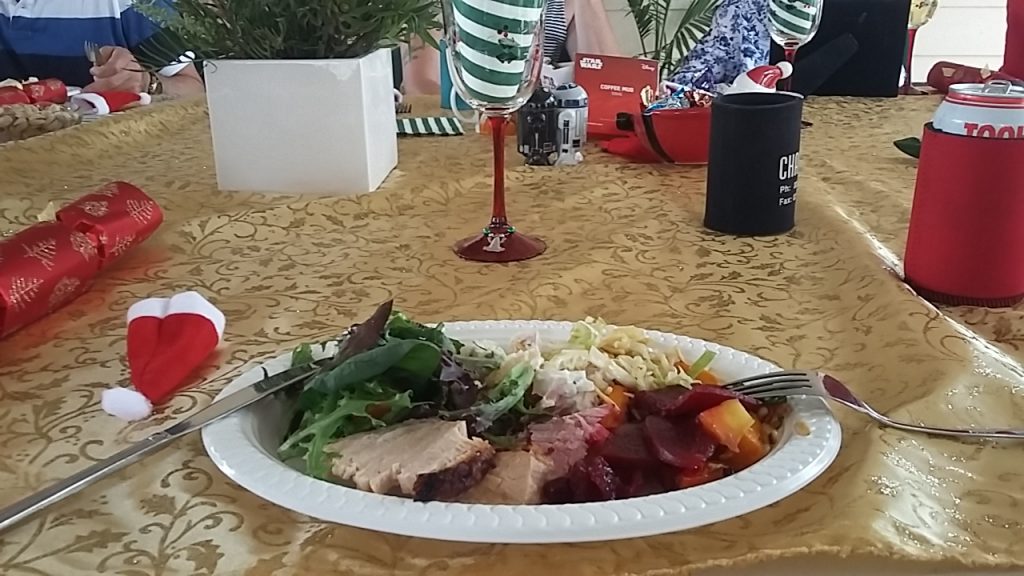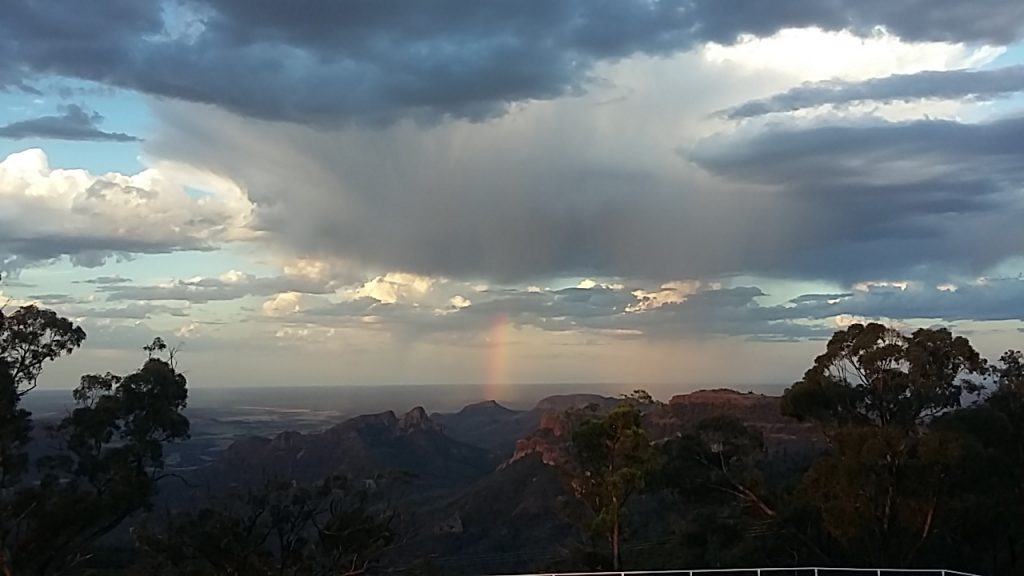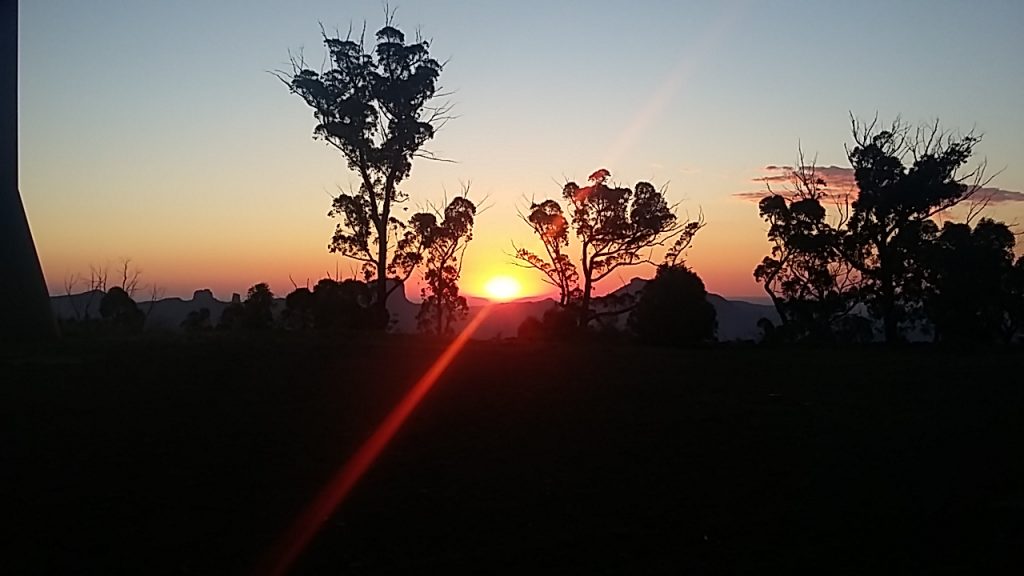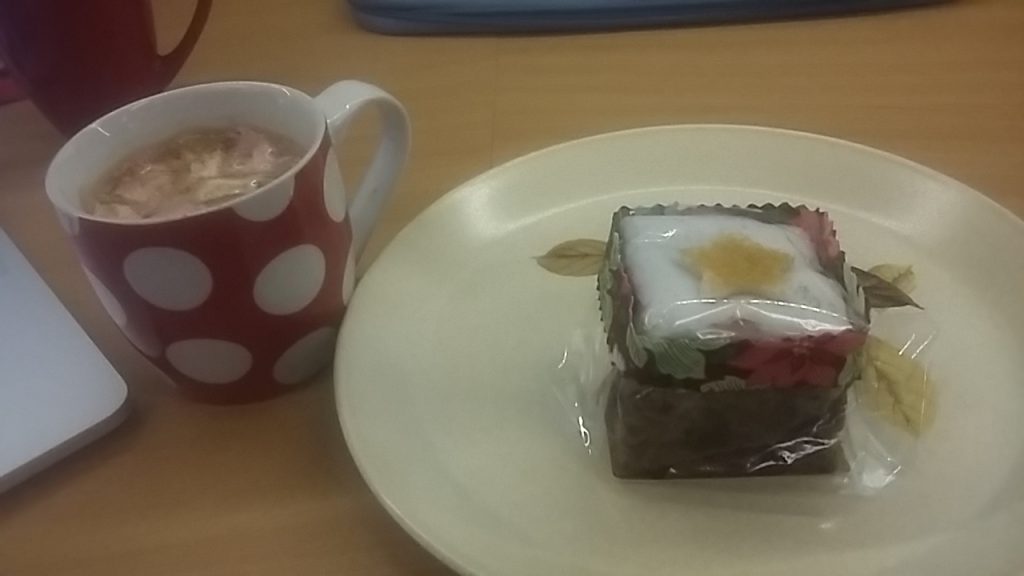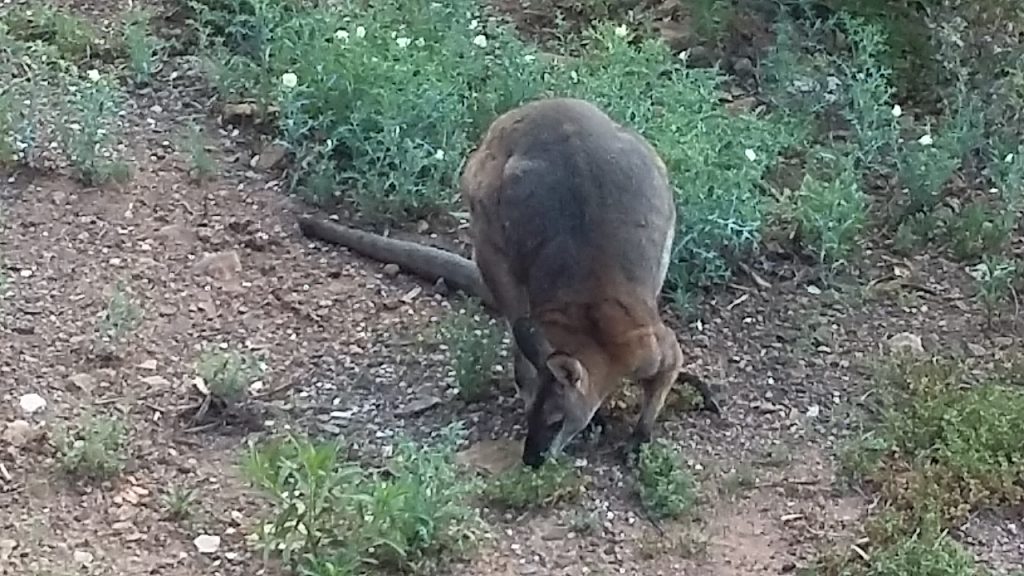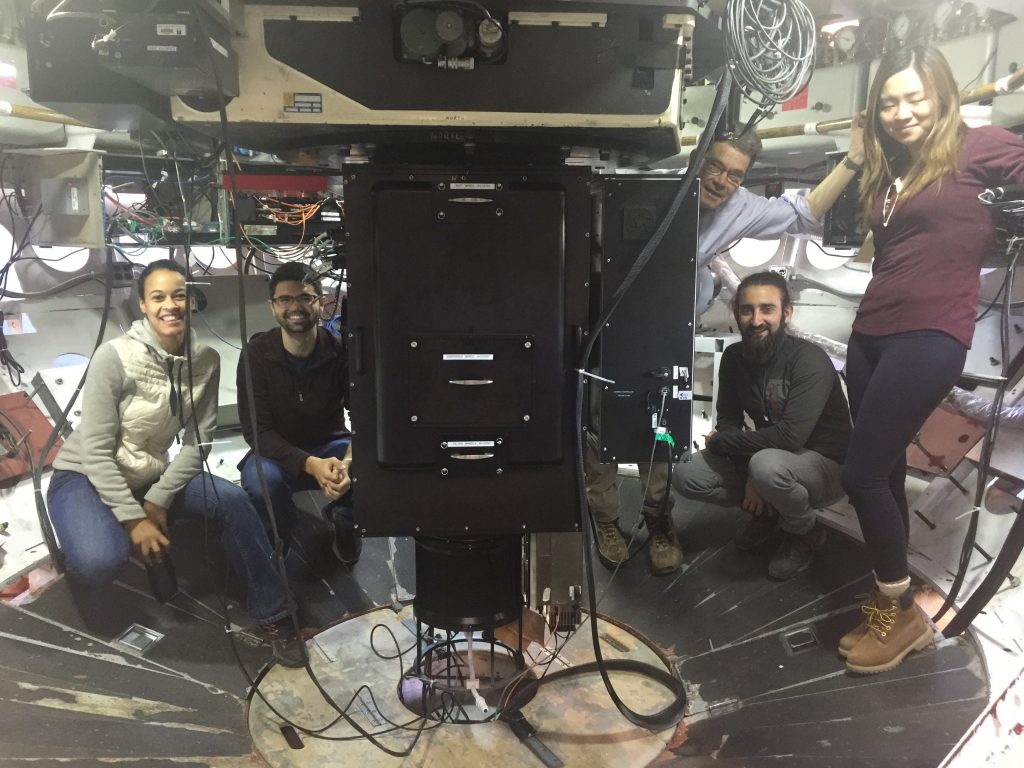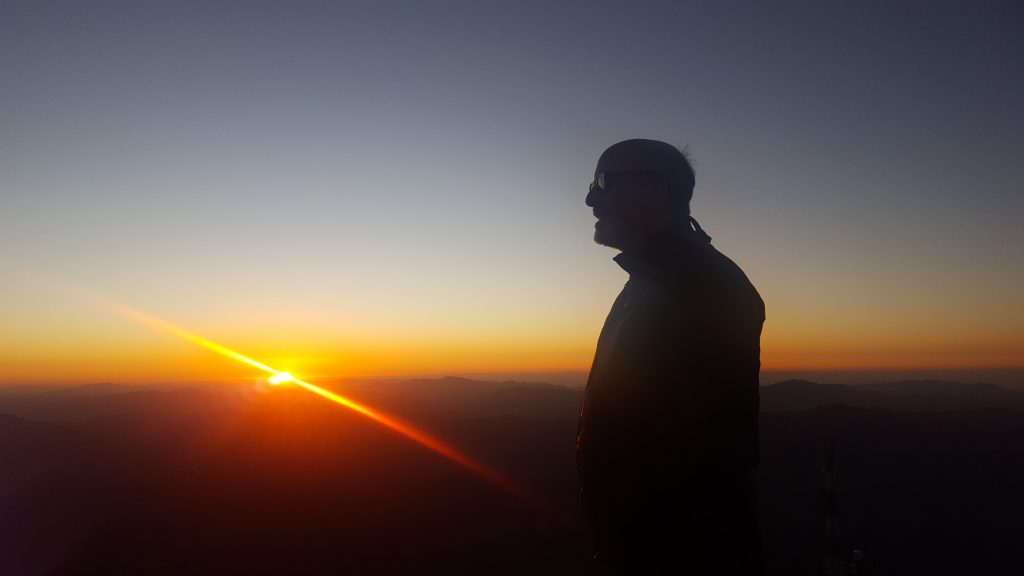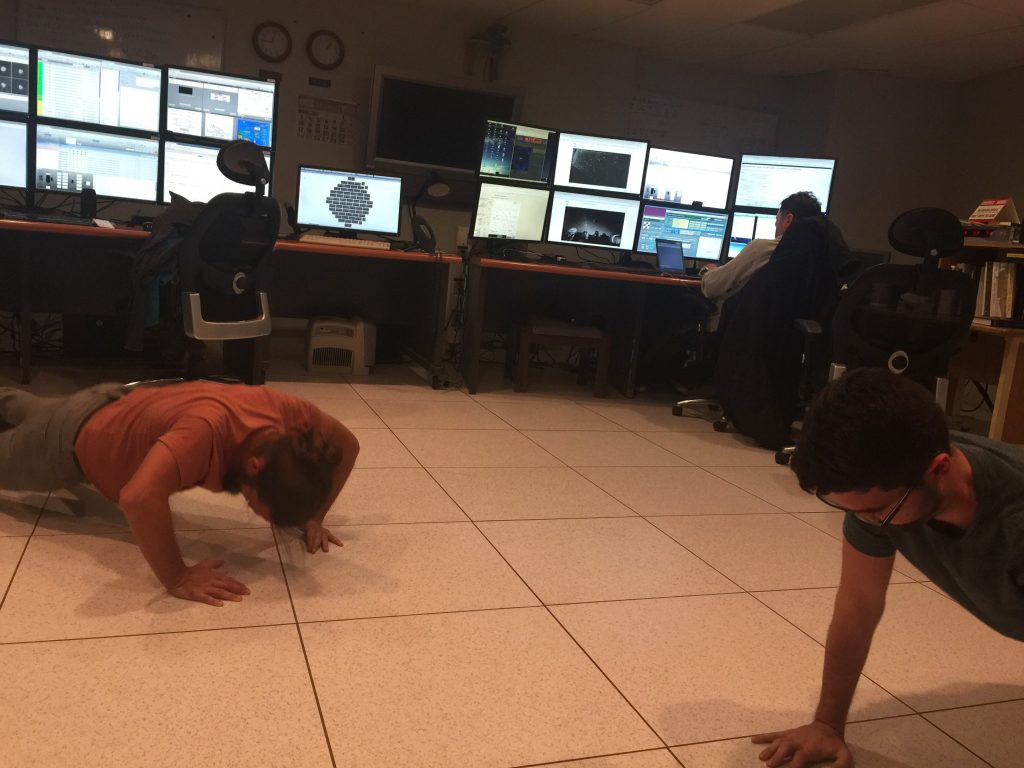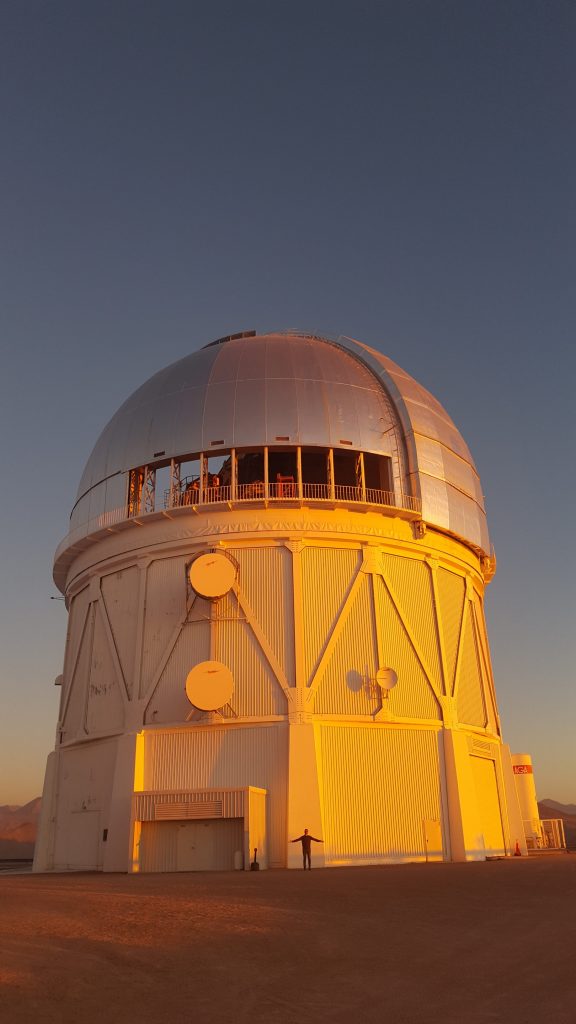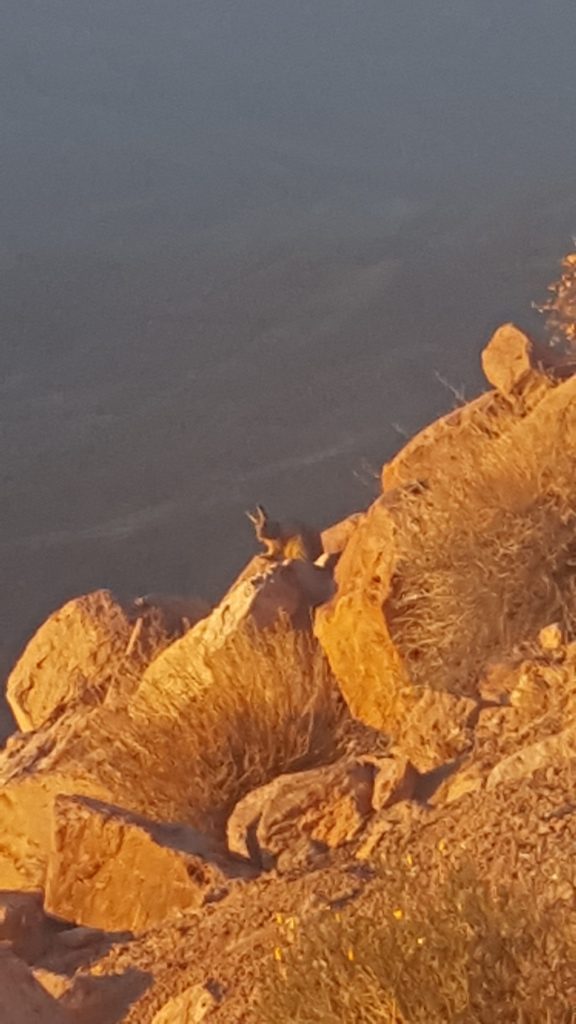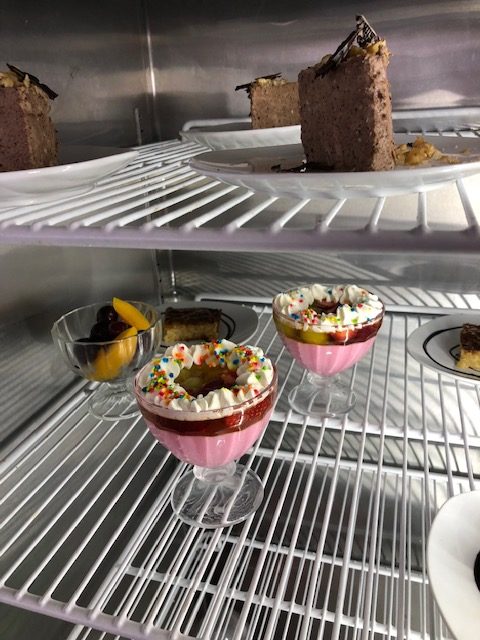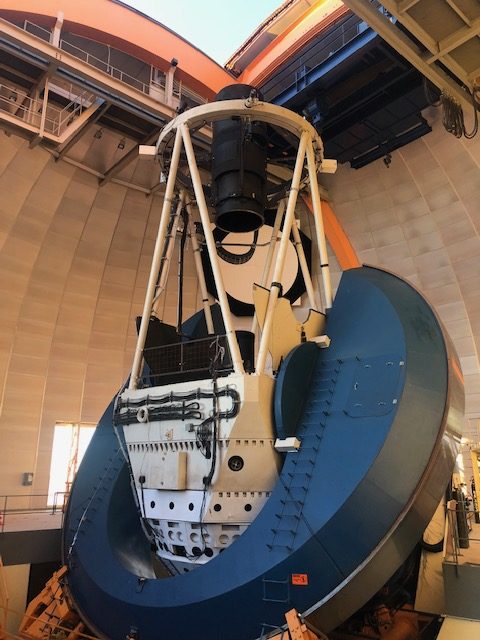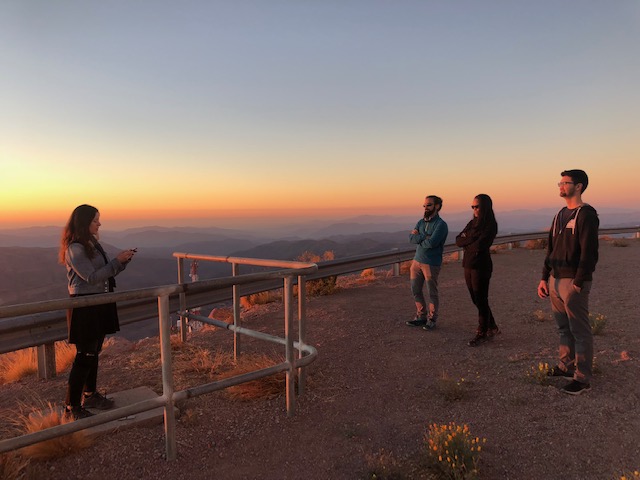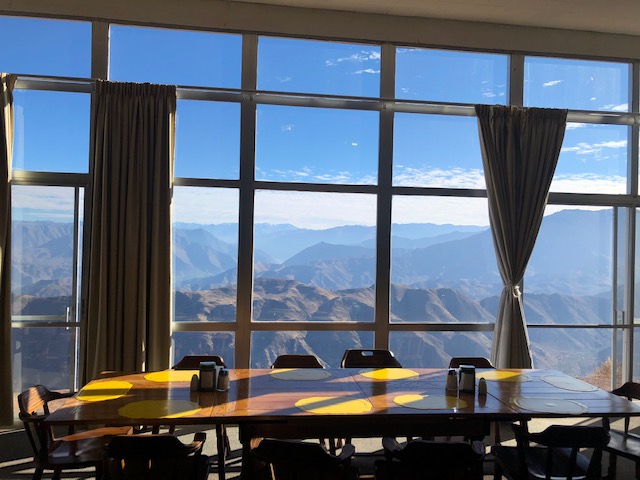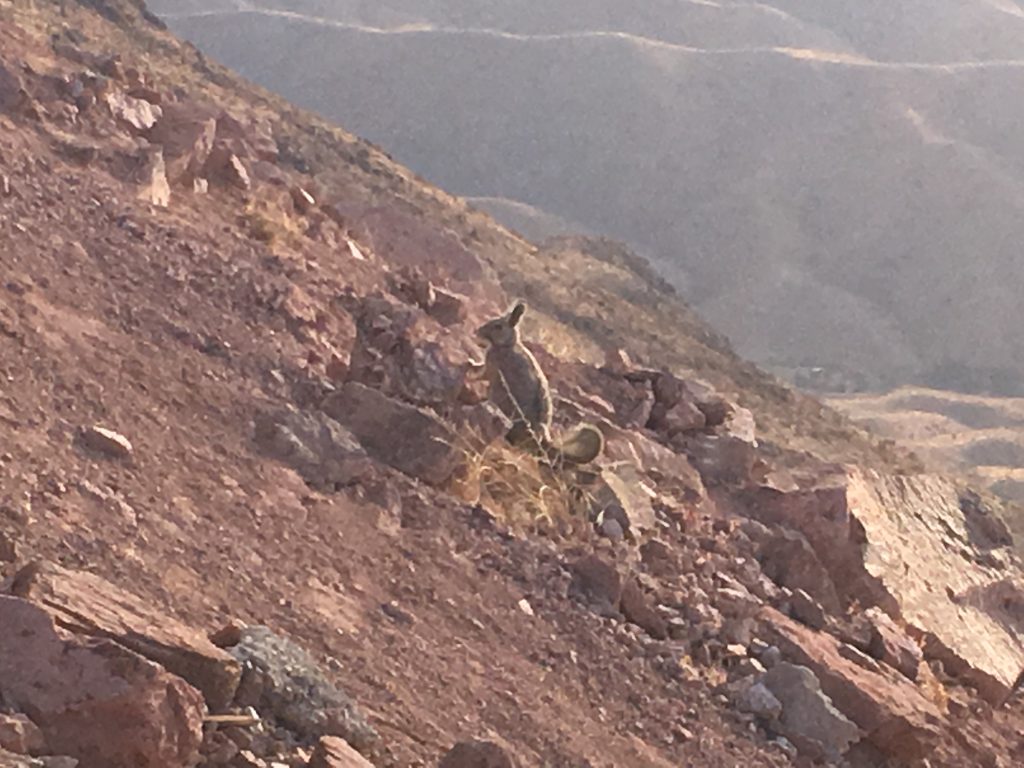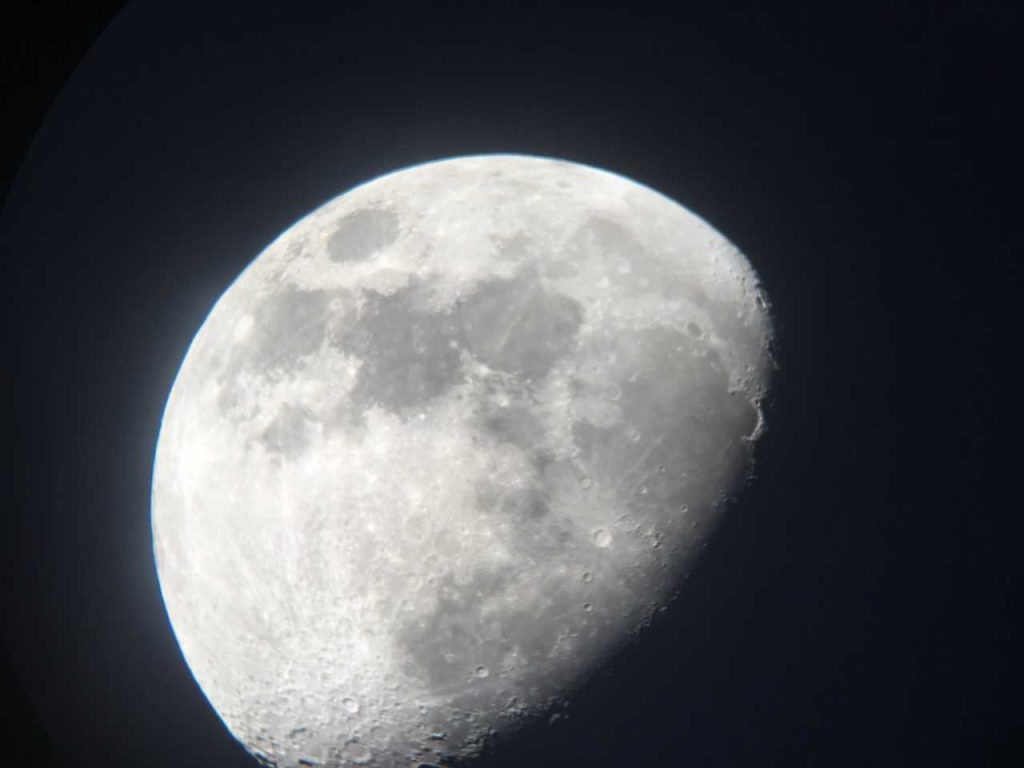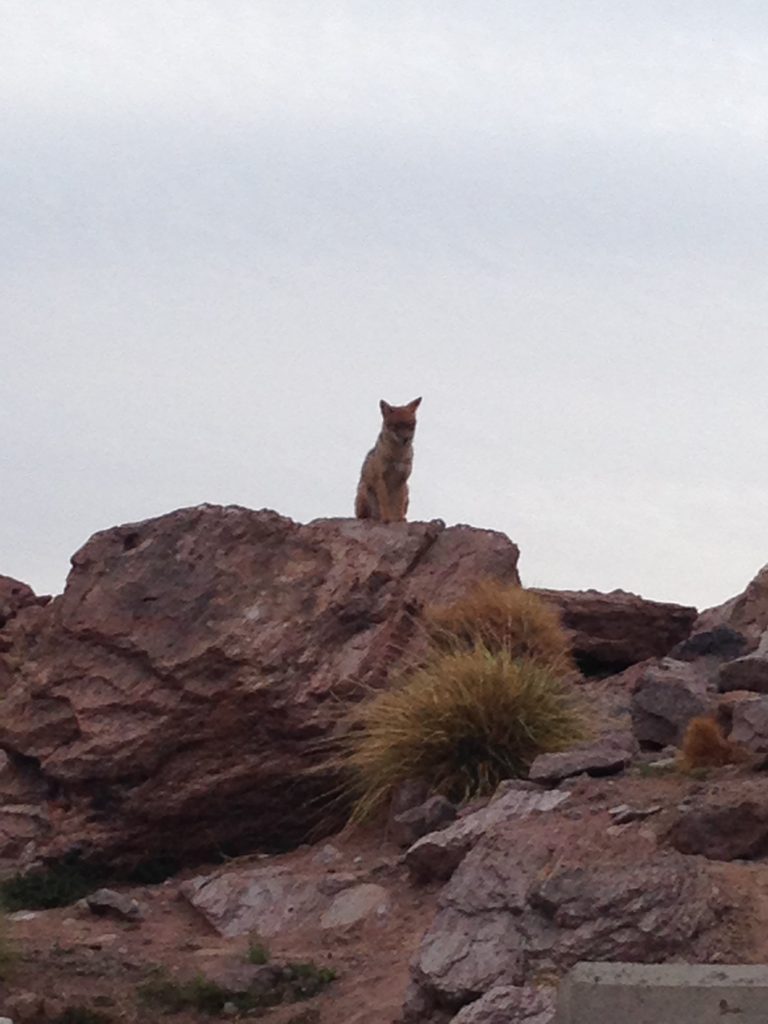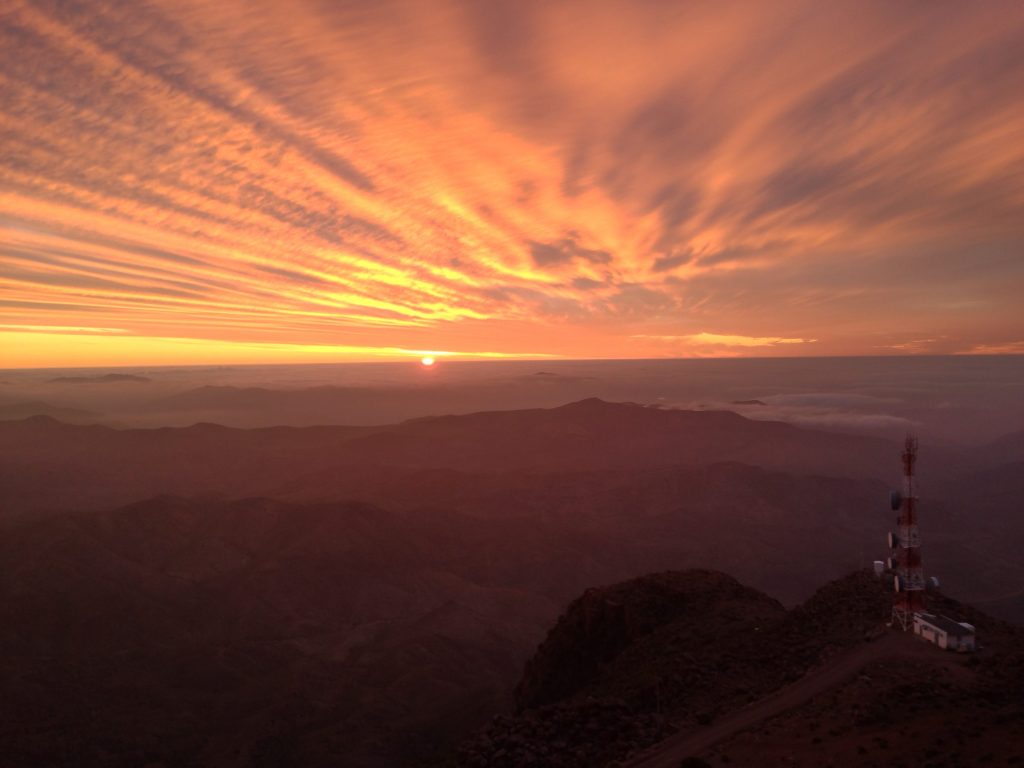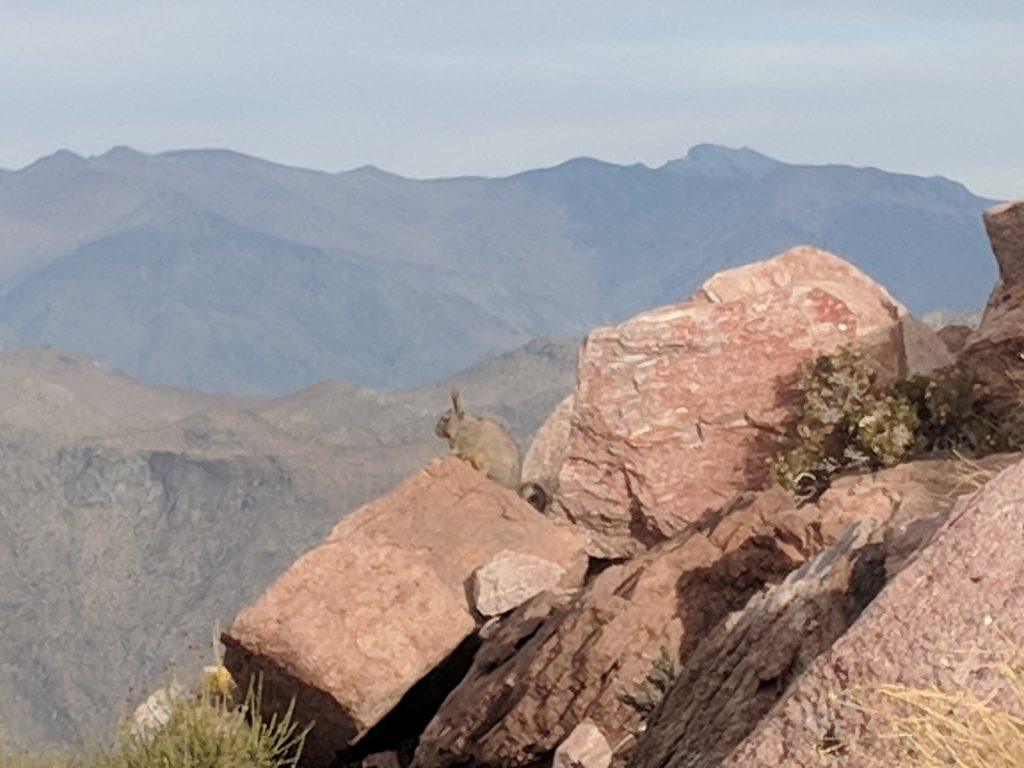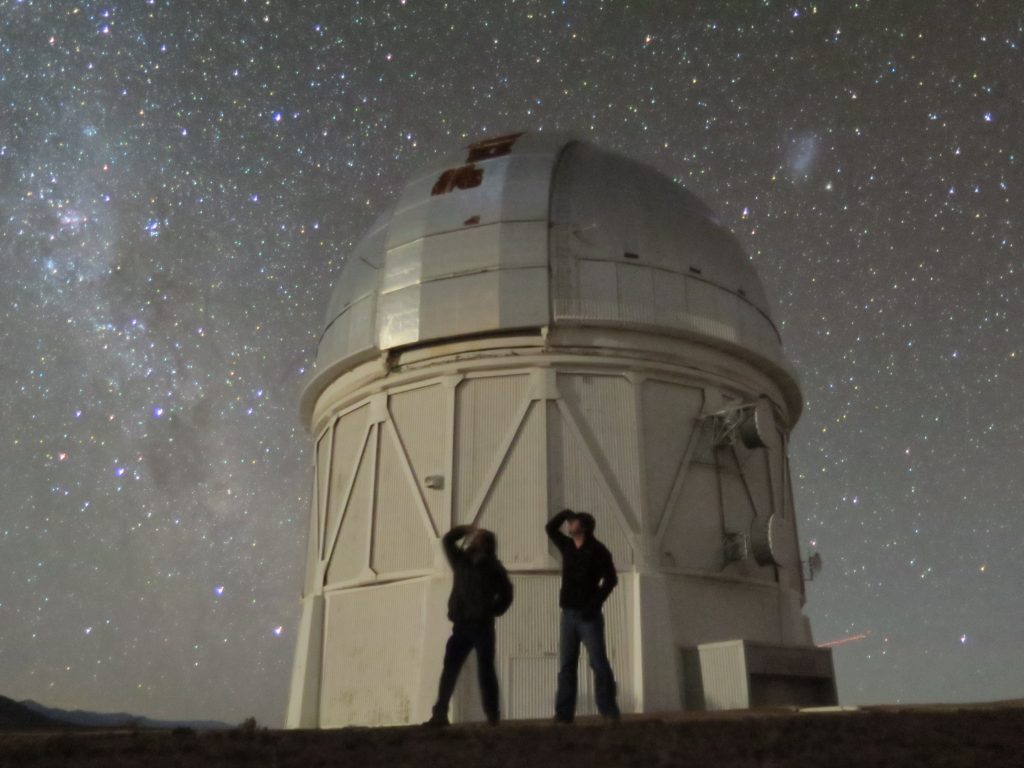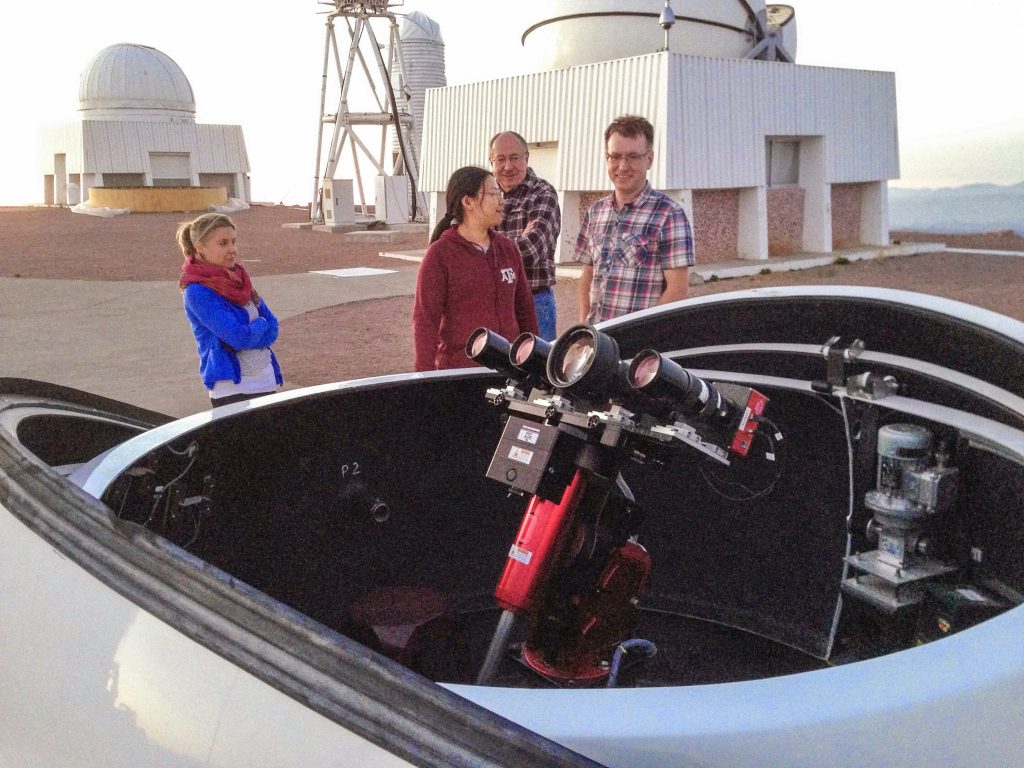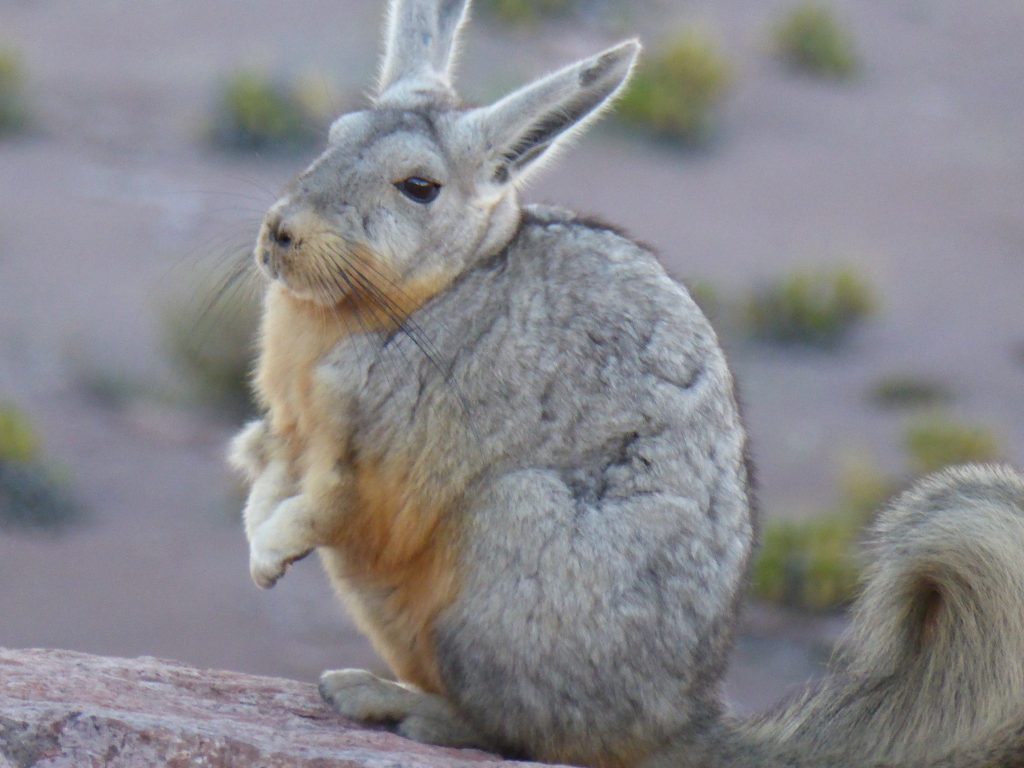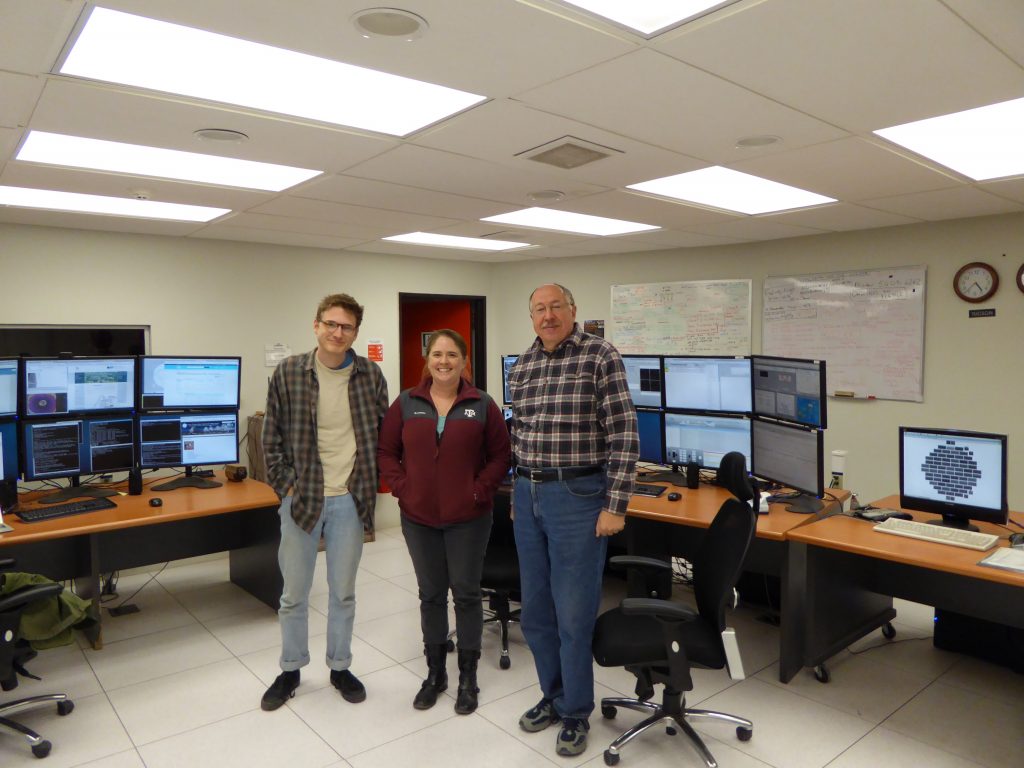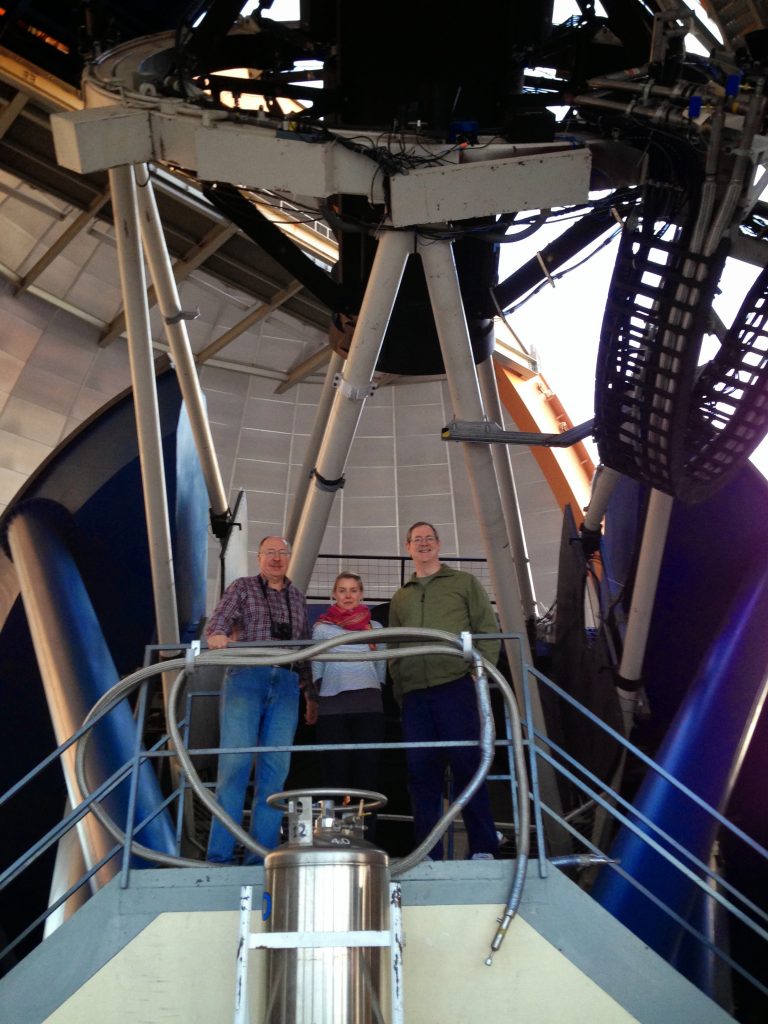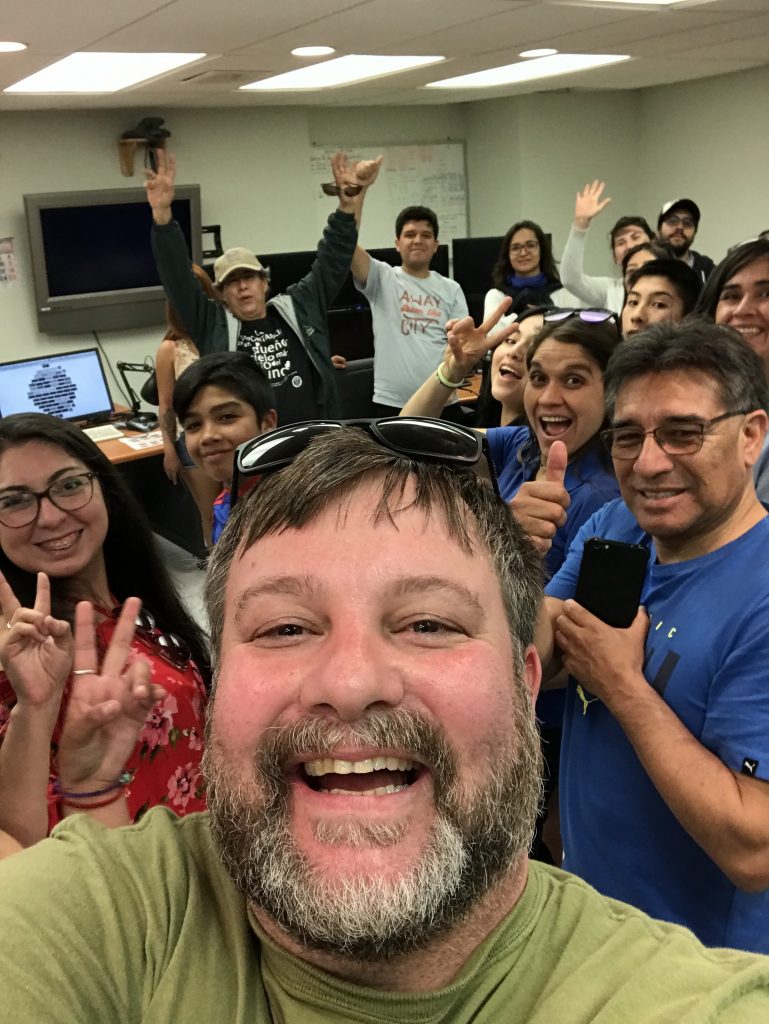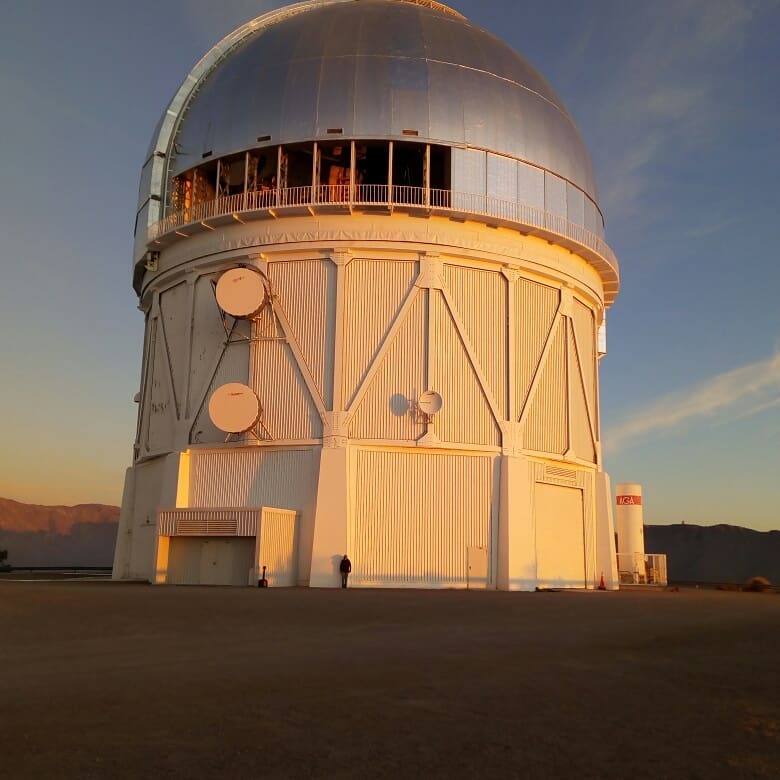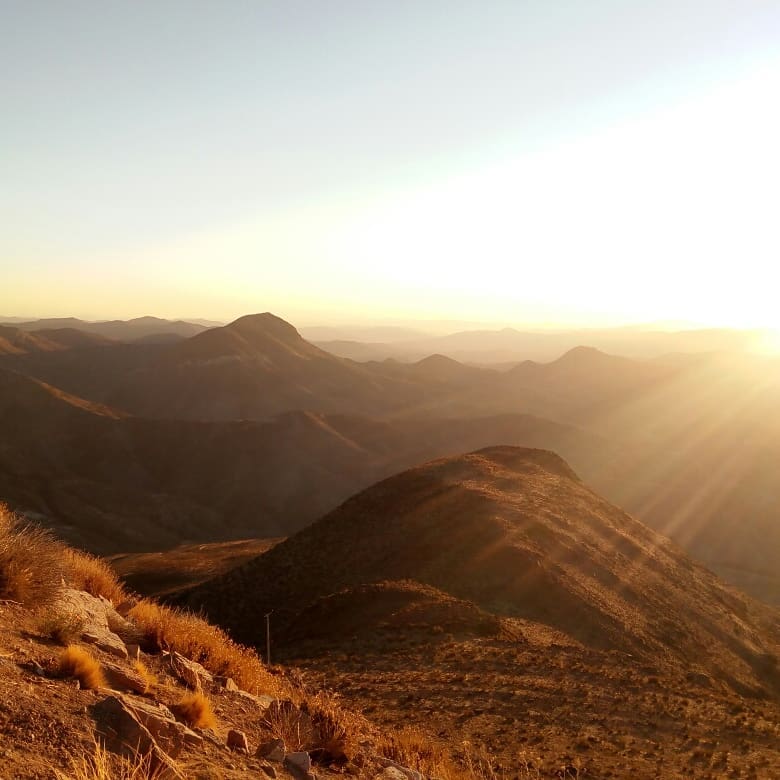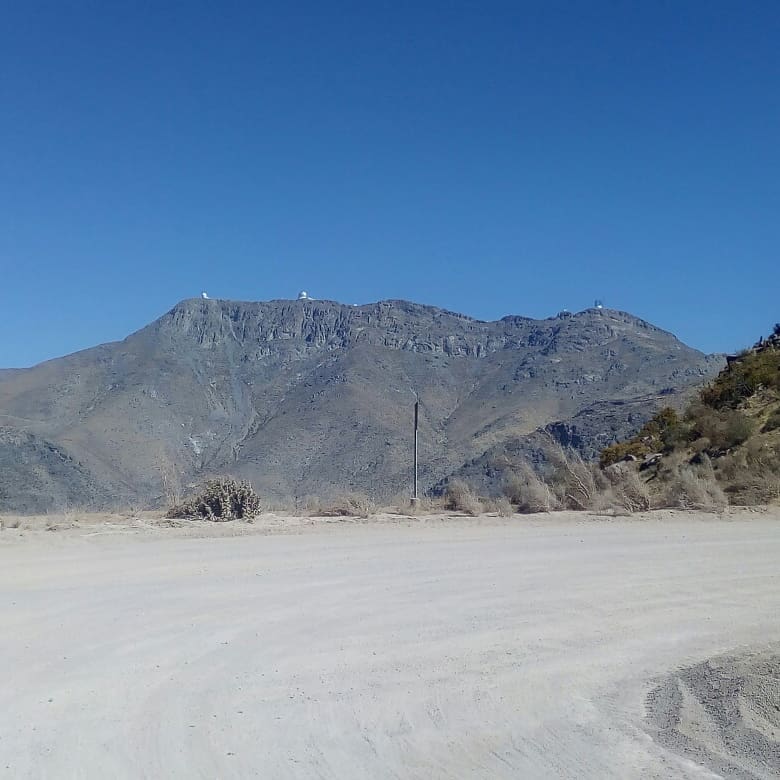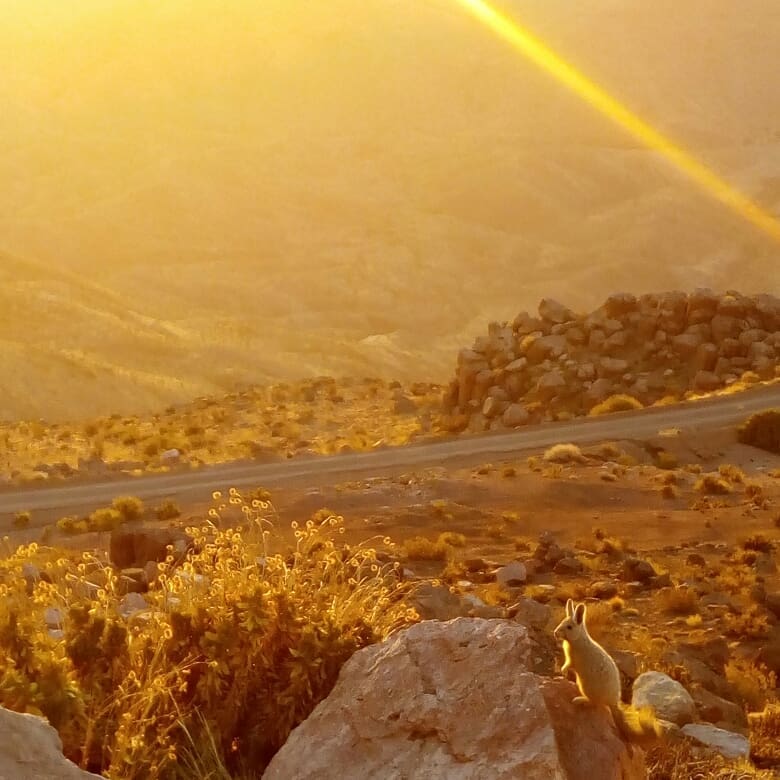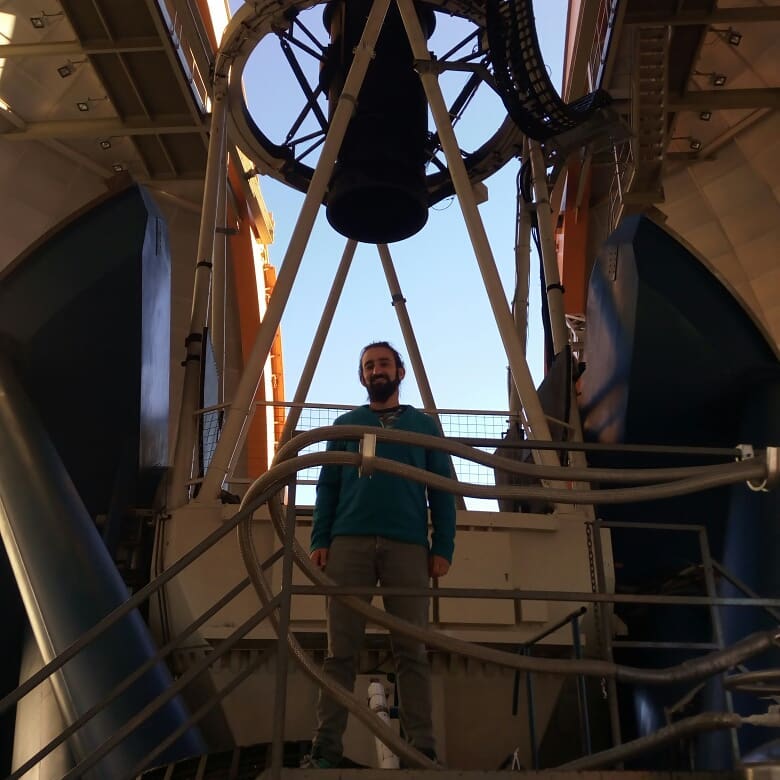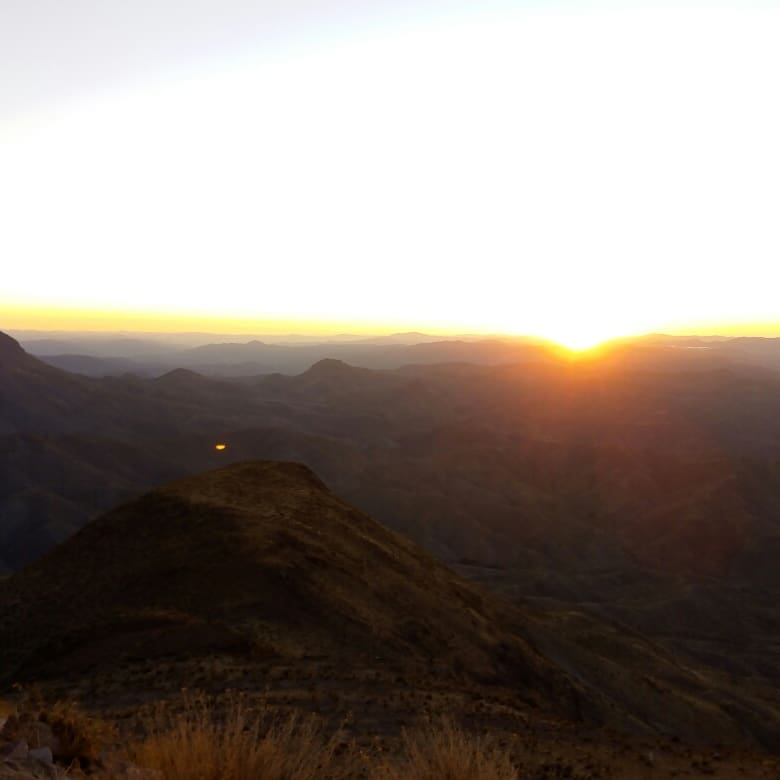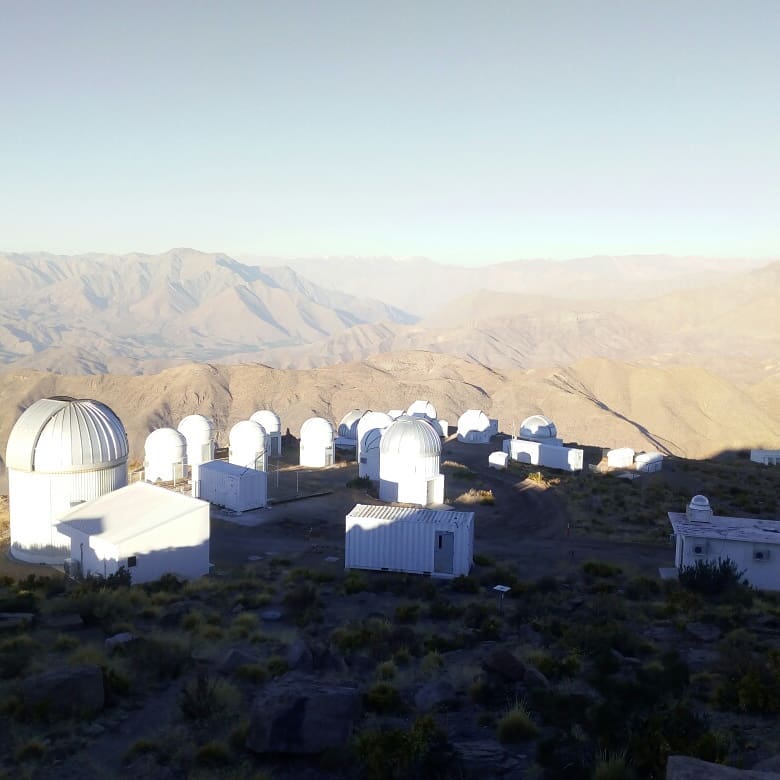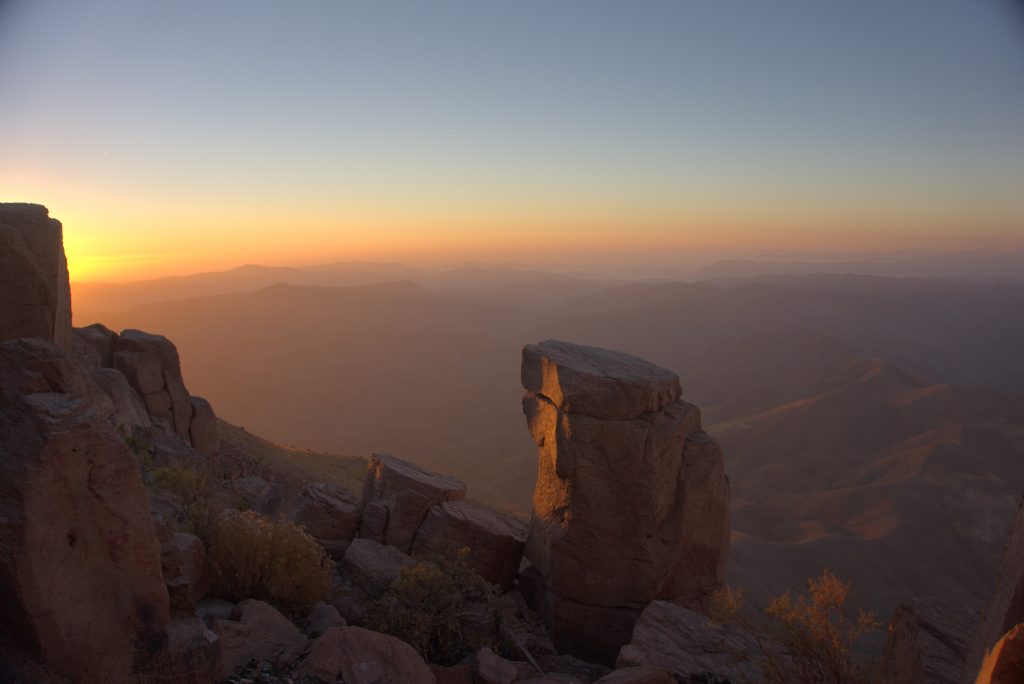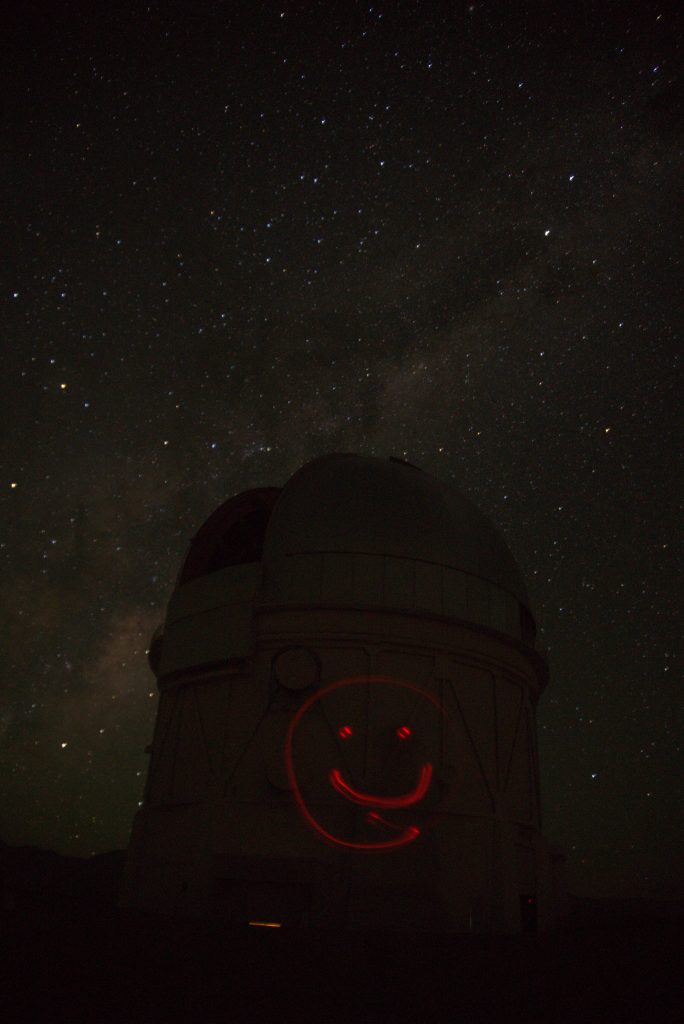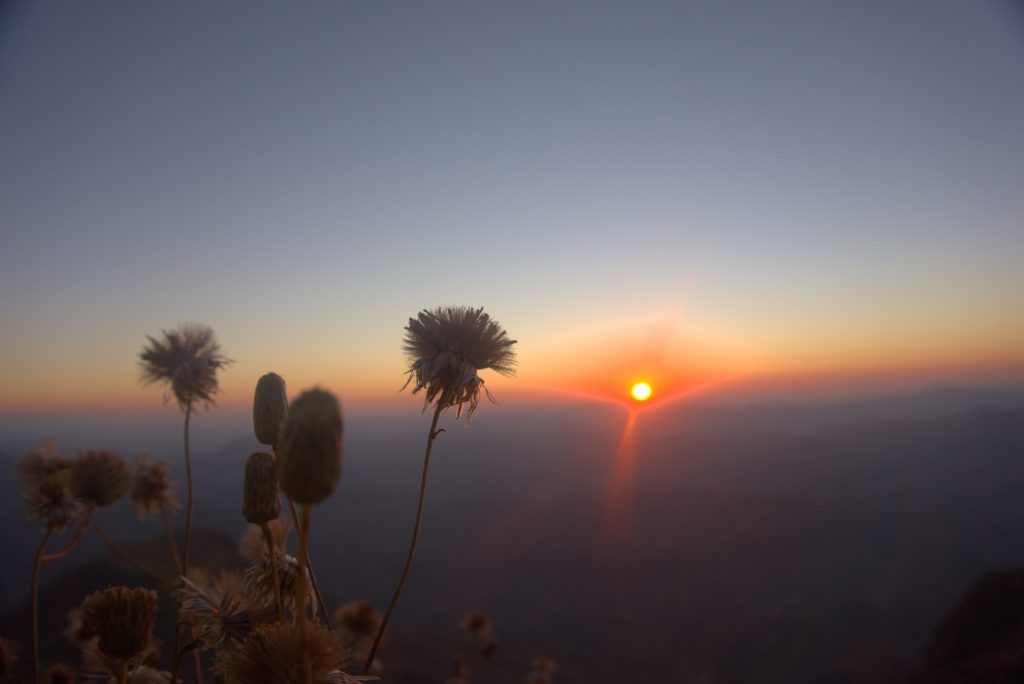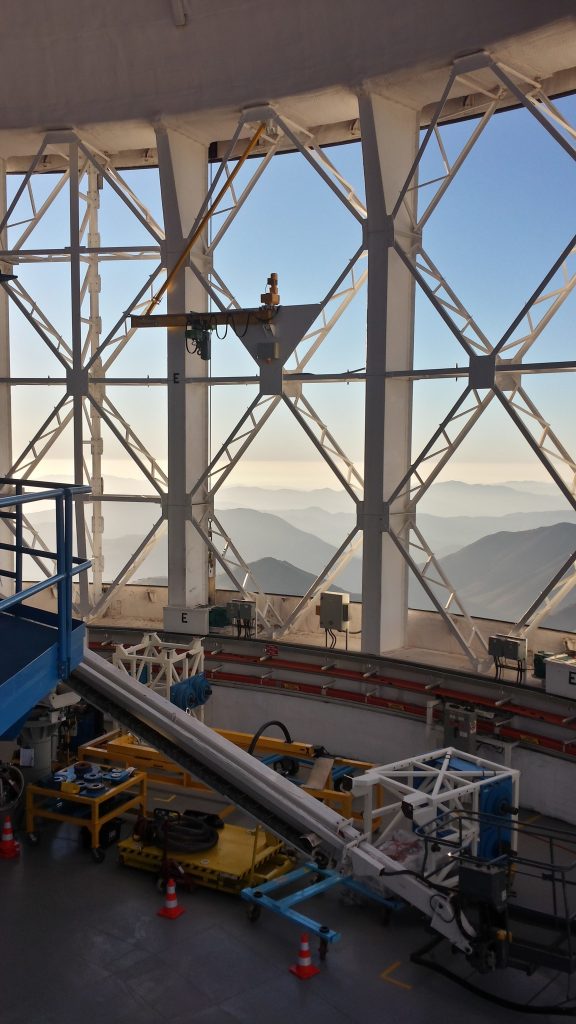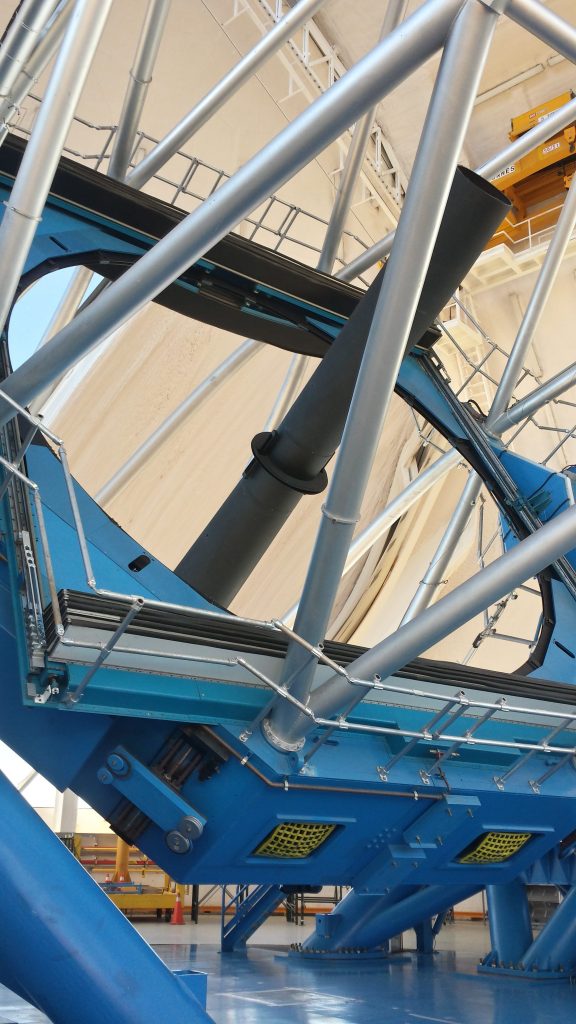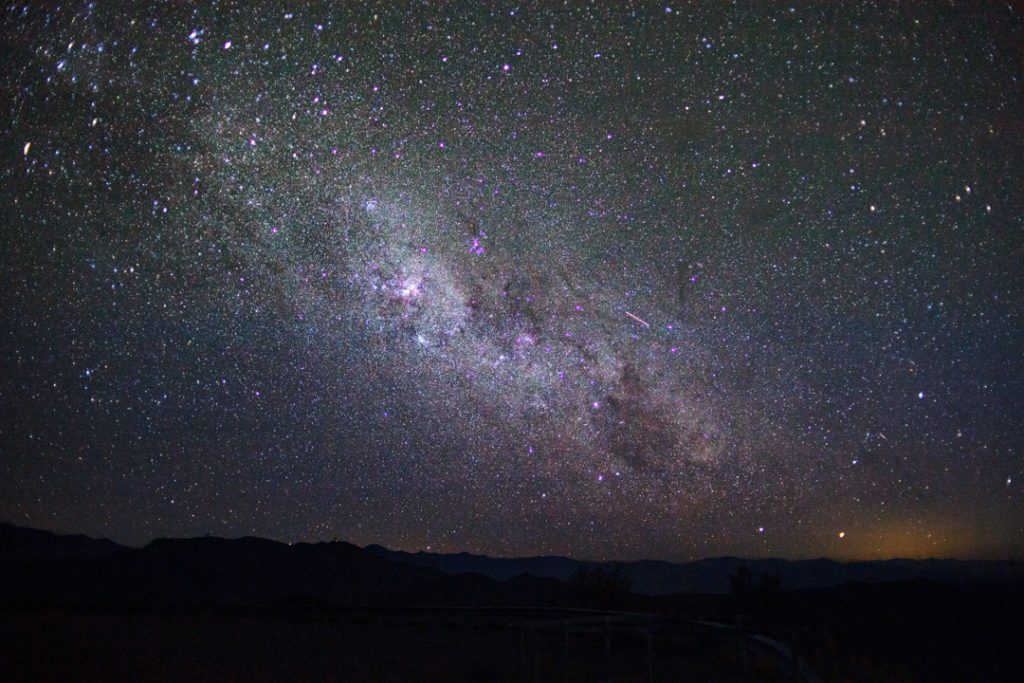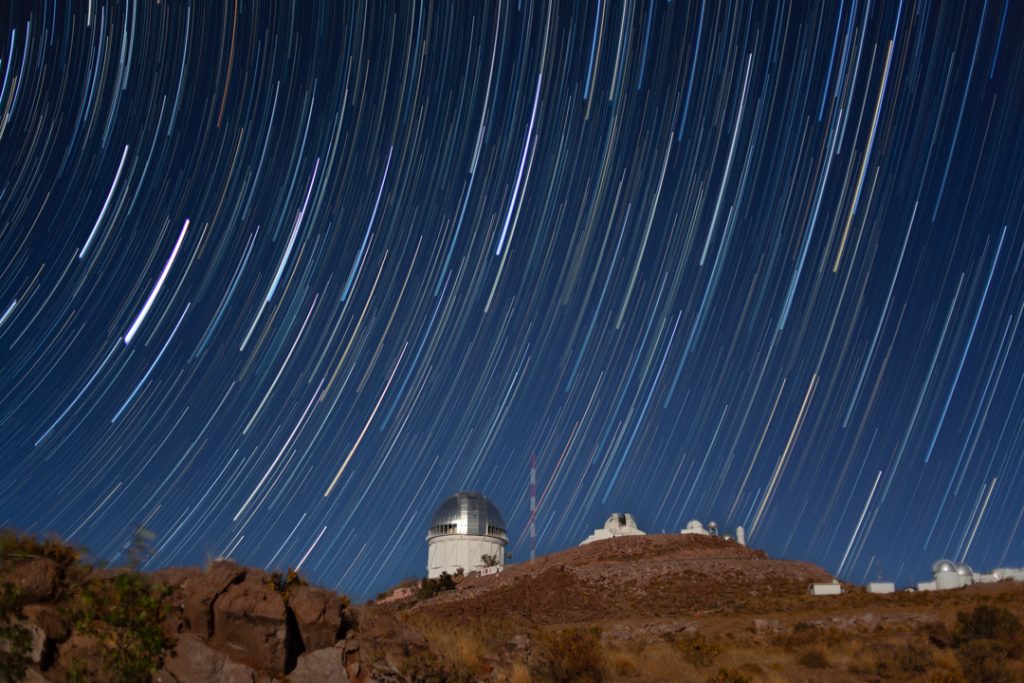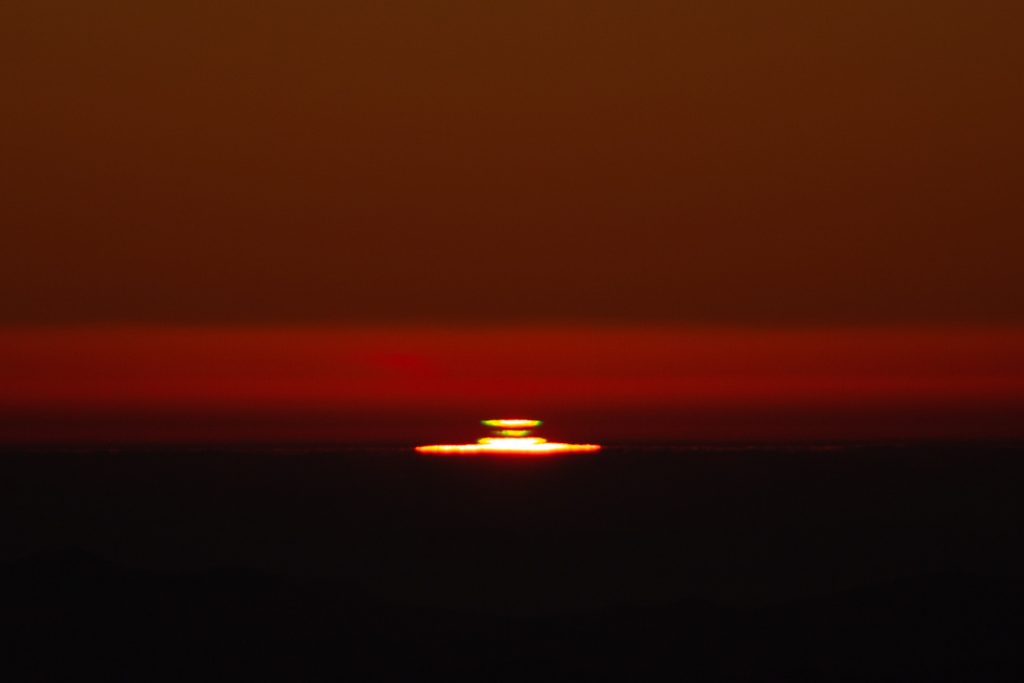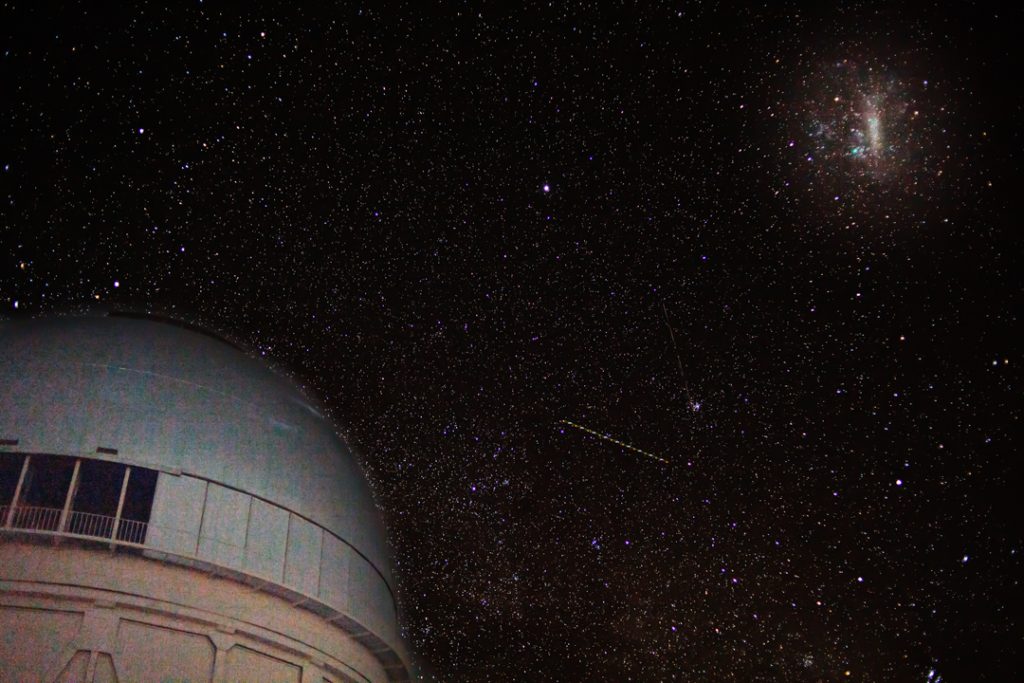On the 9th January 2019, the Dark Energy Survey took it’s final observations. Here we have a collection of memories from our observers from the last 6 years.
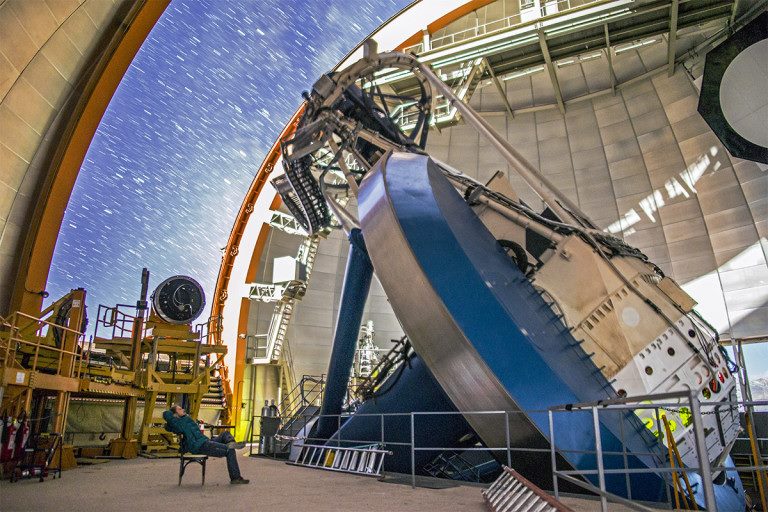
To mark the final 31 days of the Dark Energy Survey observations, we’ve collected some of our best memories of observing. We hope you all enjoy!
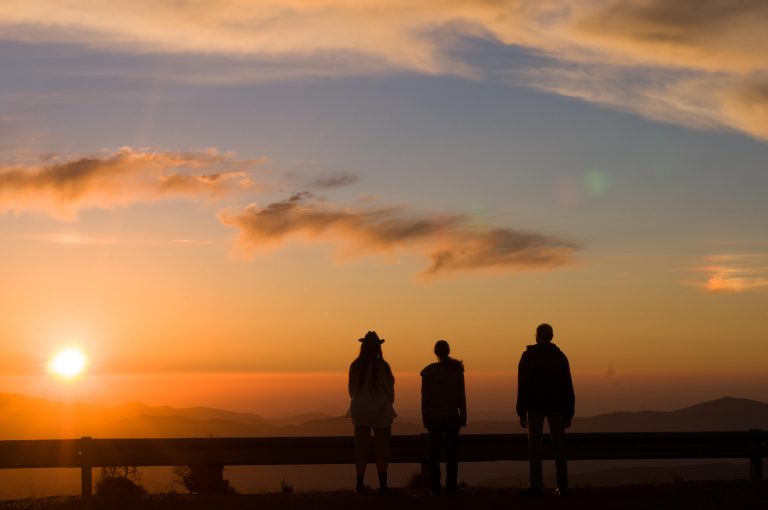
We (K. Grabowski, A. Elliott, and myself) had finished preparations for observing and were awaiting sunset. We went outside, and this photo was taken. We saw the color of the sun change as it went below the horizon, and another photo recorded a green flash! It was a fantastic moment.
Hal Spinka
Memory: 22/10/14, Blanco Telescope
One of the perks of being at the top of a mountain in Chile is watching the sunset. Some optical phenomena are very clear there; in this timelapse of the sky opposite to the sun during sunset, we can clearly see the Venus belt (pink band) followed by the Earth’s shadow (blue band on the horizon). One of the perks of being at the top of a mountain in Chile is watching the sunset. Some optical phenomena are very clear there; in this timelapse of the sky opposite to the sun during sunset, we can clearly see the Venus belt (pink band) followed by the Earth’s shadow (blue band on the horizon).
Agnès Ferté, Postdoc NASA JPL
Memory: Blanco Telescope
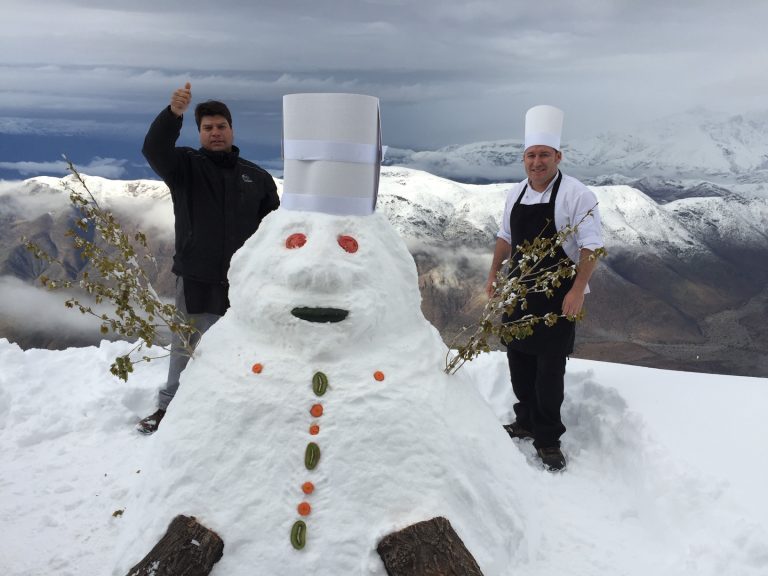
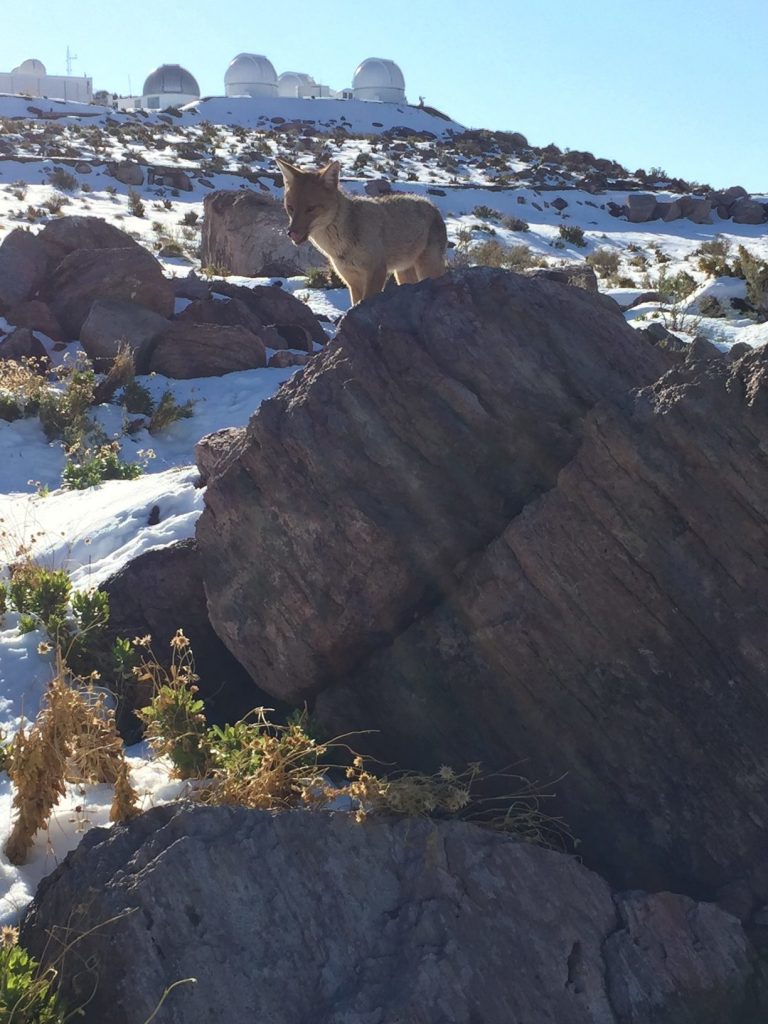
The weather can be unpredictable on the desert mountaintop. In mid-Oct 2015, blizzard conditions made for a few days with clouds and no data collection. Life goes on. One of the best parts of observing is meeting and working with the Chilean staff at the observatory. Occasionally, there is a little fun and I got to enjoy making this snowman!
William Wester
Natural critters like the Culpeo (South American Fox) remind us that we are only scientific visitors to this wonderful remote place on earth where the skies provide some of the best conditions on the planet for observing. It should be of no surprise that this fox was seen rather close to our dormitory and, of course, the kitchen where some food might be more easily found than out in the snow. His footprints next day were also found around our snowman who had some missing shirt buttons!
Memory: 14/10/15, Blanco Telescope

December 12th, 2012 was the turning of the Mayan Baktun. I retired to my mountain stronghold for the whole month, and helped prepare the world’s largest camera for science verification data taking. At the end of the month, the telescope was mostly working, the beautiful camera was mostly working, and science verification was on-going.
James Annis, Fermilab
Memory: 12/12/2012, Blanco Telescope
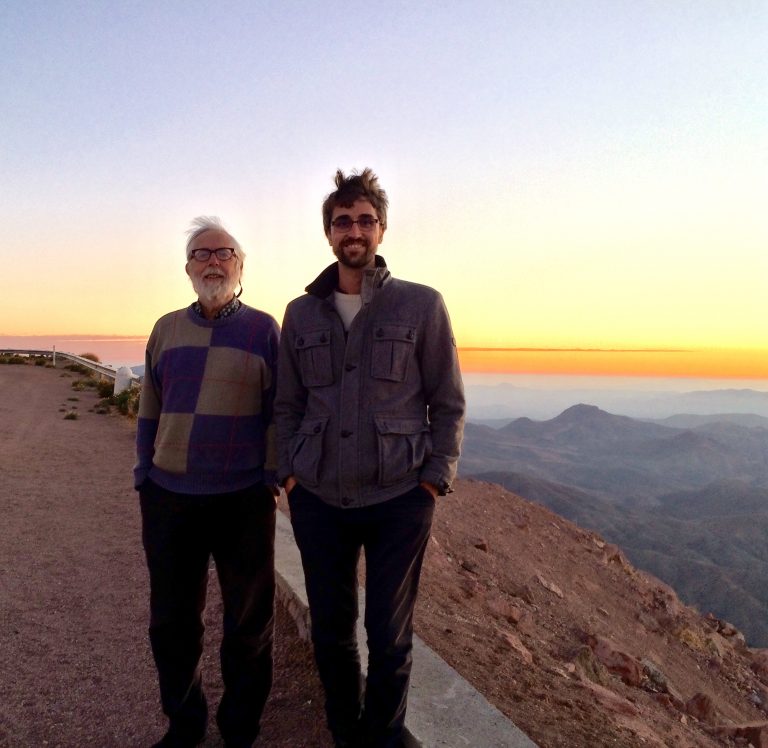
Almost 30 years ago, Frank Valdes was the first to detect the weak gravitational lensing effect of galaxy clusters in images taken with the Blanco Telescope. Today, we’re still using Blanco, with DECam, for the most accurate and precise cluster weak lensing studies to date
Daniel Gruen
Memory: 30 years ago, Blanco Telescope
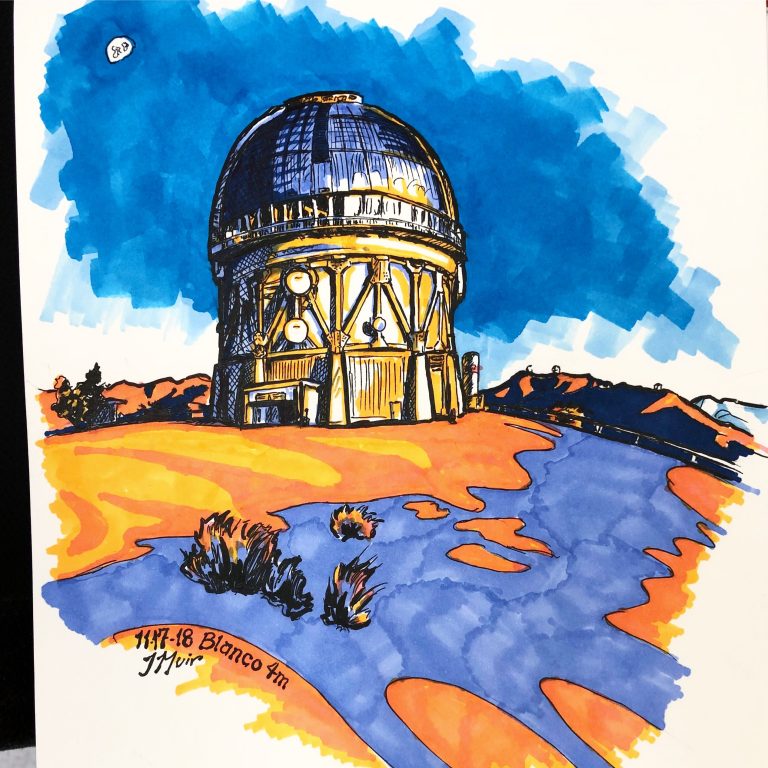
I really loved being able to watch the sunsets from the top of Cerro Tololo; I sketched the Blanco telescope while sitting on the mountaintop and waiting for the sun to go down. The mountain in the background on the right is Cerro Pachón, and the little bumps on it are other telescope domes. From left to right they are the SOAR telescope (which I remember learning about in my intro astronomy class at Michigan State University!), Gemini South, and the Large Synoptic Survey Telescope (also known as LSST, currently under construction).
Jessie Muir, Porat Fellow Stanford University
Memory: Blanco Telescope
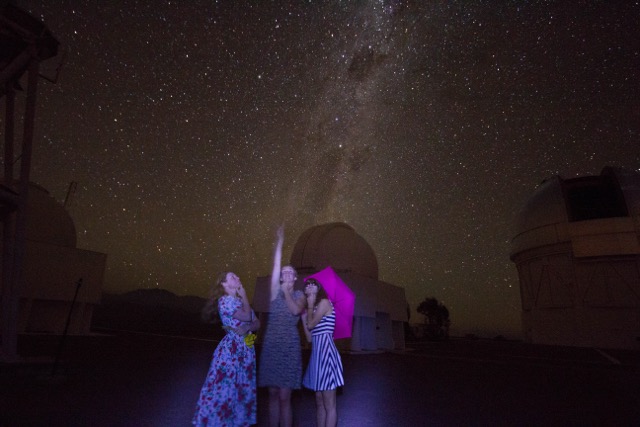
We were one of the last DES Y3 observing shifts (18/01/15 to 24/01/15). Stay tuned for cosmology constraints from Y3 coming soon!
Elisabeth Krause
Memory: Blanco Telescope
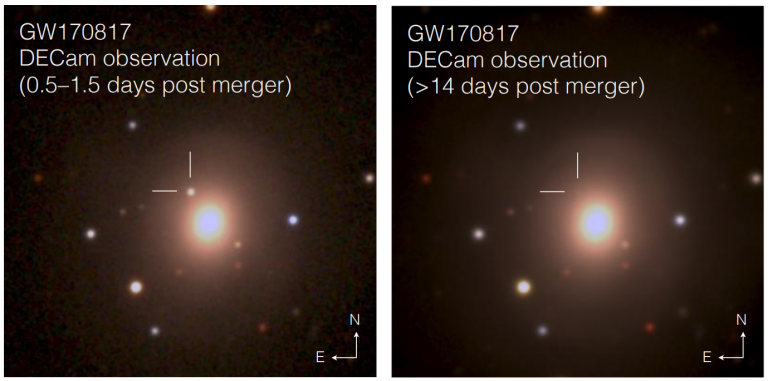
During my time observing for DES, what I enjoyed most was being at CTIO during the announcement of the first ever neutron star merger event. Knowing that the galaxy which hosted this energetic, exciting event was observed in the same control room as our routine nightly observations was at once humbling and totally awe-inspiring.
Sunayana Bhargava, PhD Student University of Sussex
Memory: Blanco Telescope
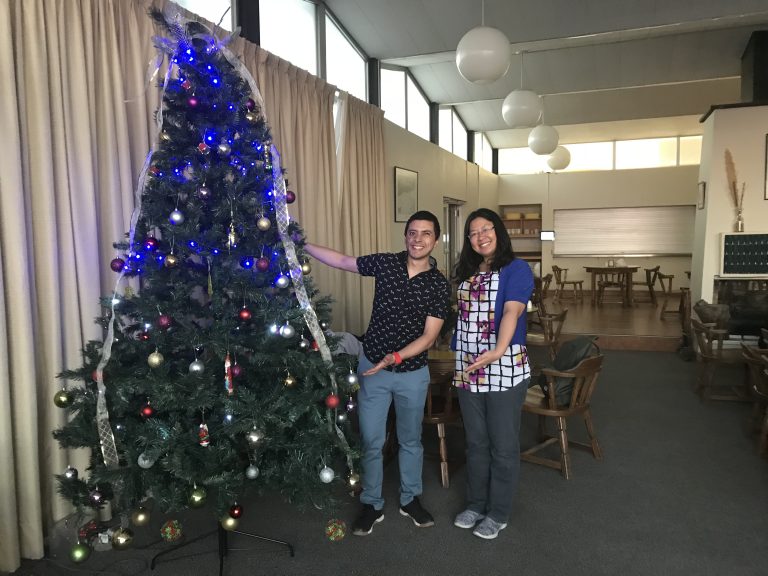
My best memories of DES observing are from observing runs during Xmas. I have had many observing runs during Xmas time and the food on Xmas Eve is gorgeous. Everyone on the mountain has dinner together, including the staff and their families. It is a great experience and memory.
Ting Li
Memory: 25/12/16 & 25/12/17, Blanco Telescope

One of Elisabeth Krause’s (University of Arizona) best memories of DES observations was nearly not being able to find the telescope!
Elisabeth Krause, University of Arizona
Memory: Blanco Telescope
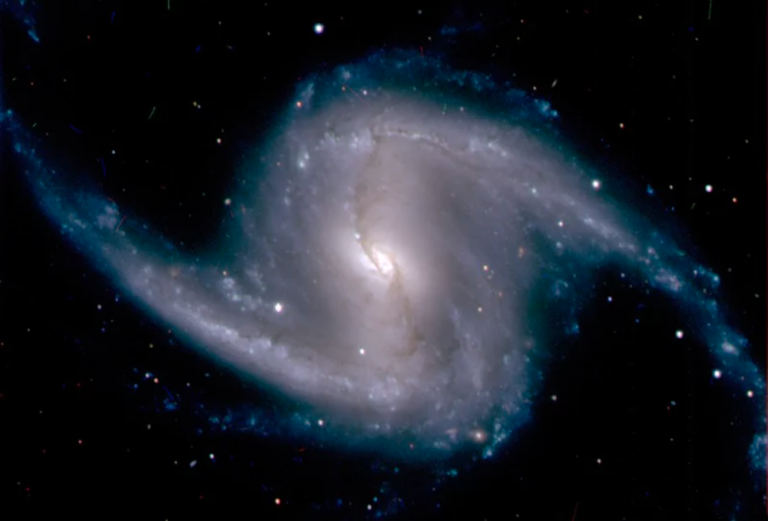
I was at the telescope for first light (the first time the telescope takes an image). Among other things we observed the galaxy NGC 1365. I reduced the image on the fly and it became an icon of that amazing milestone. It was wonderful to be there, with my colleagues. I will forever cherish that memory!
Marcelle Soares-Santos, Assistant Professor Brandeis University
Memory: Blanco Telescope
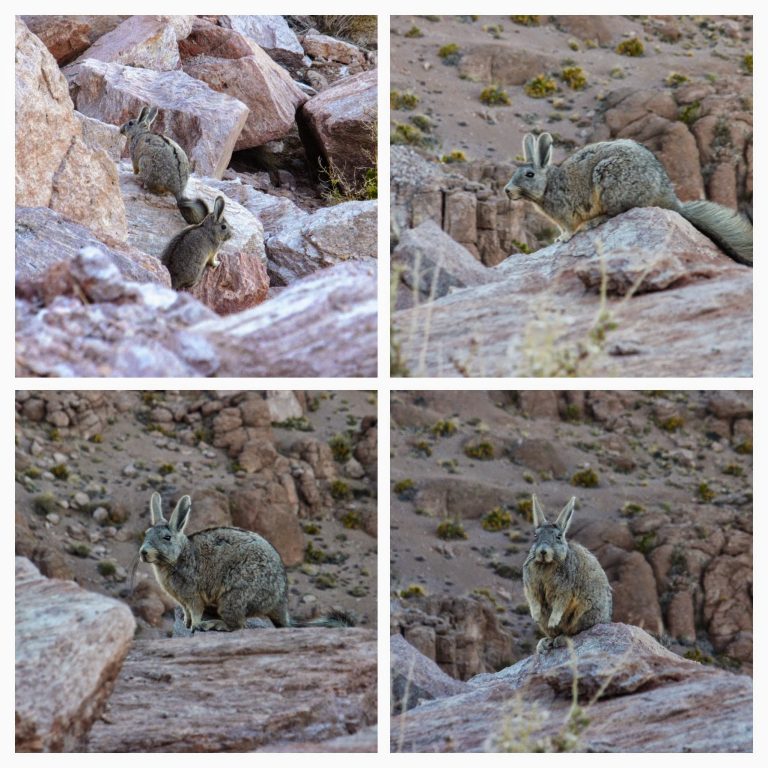
Watching furry vizcachas at the observatory during sunset is always amazing.
Ricardo Ogando, Staff Scientist at Observatorio Nacional of Brazil and LIneA
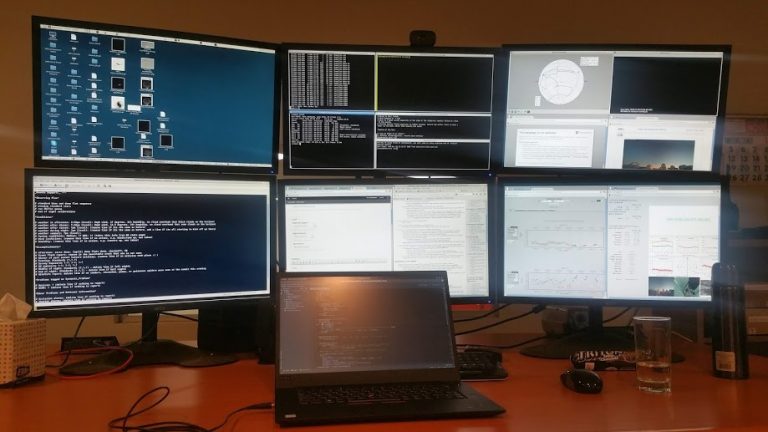
I just got done with an observing shift for DES and am on my way back to Michigan to celebrate Thanksgiving with my family. While sitting in the Santiago airport, I’m reflecting on what a unique and rewarding experience working an observing shift for DES has been, and am grateful to have had the opportunity. I’m a theorist, so usually when I work with data from DES, it’s already been significantly processed thanks to the effort of many other members of the DES collaboration.
Jessie Muir, Porat Fellow at Stanford University
Getting the chance to spend time in the telescope control room makes me feel all the more appreciative of the work they put in, and of what a team effort it is to do the science it takes to go from CCD readouts from DECam, to weak lensing and galaxy clustering measurements, to constraints on the properties of dark energy.
Memory: Blanco Telescope
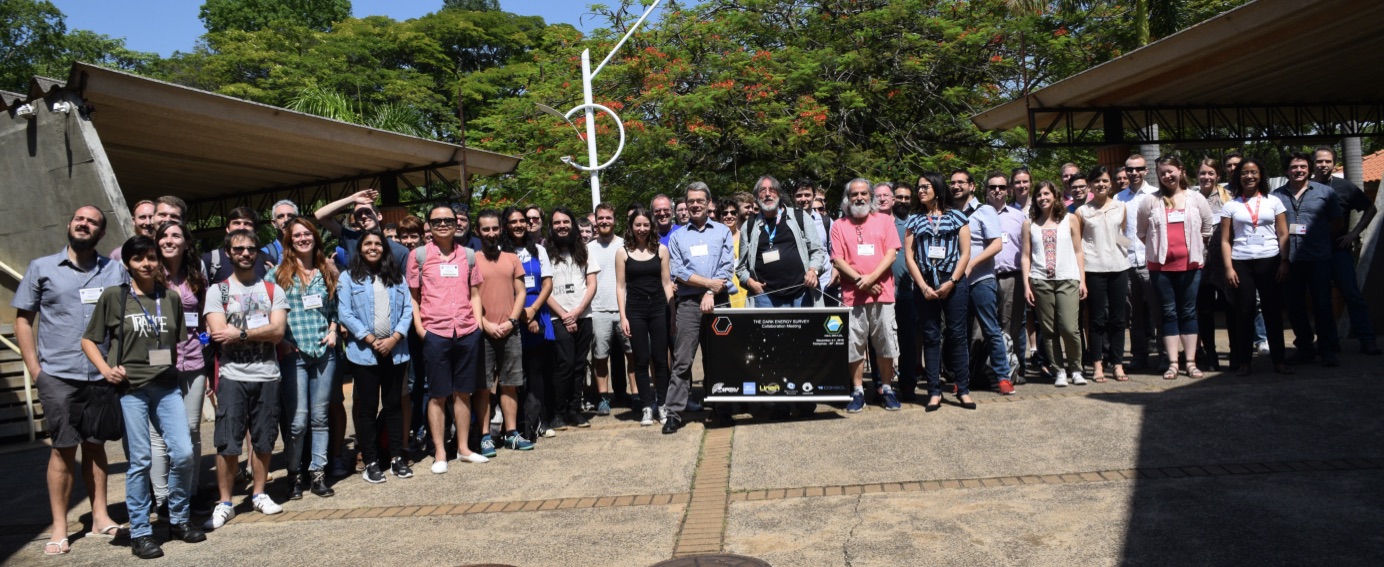
I’ve likely mentioned this before but for me it’s the people that are my best memory. Commissioning a new instrument is a challenge. The kind of challenge that you only really want to share with people who are talented and passionate about what they do. In the midst of those challenges you form lasting relationships. You learn who can be counted on when the challenges are the hardest. People that can be counted on even after you’ve moved on to whatever is next.
Kevin Reil, Staff Scientist at SLAC National Accelerator Laboratory
As many of the DES team know, I’m now the commissioning scientist (DOE) for LSST along with Chuck Claver as the lead. That will have me spending a great deal of time in Chile including relocating my family there for some time. Near the top of my list for people I love to work with are the people in Chile. I’m looking forward to my continued adventures.
Memory: Blanco Telescope
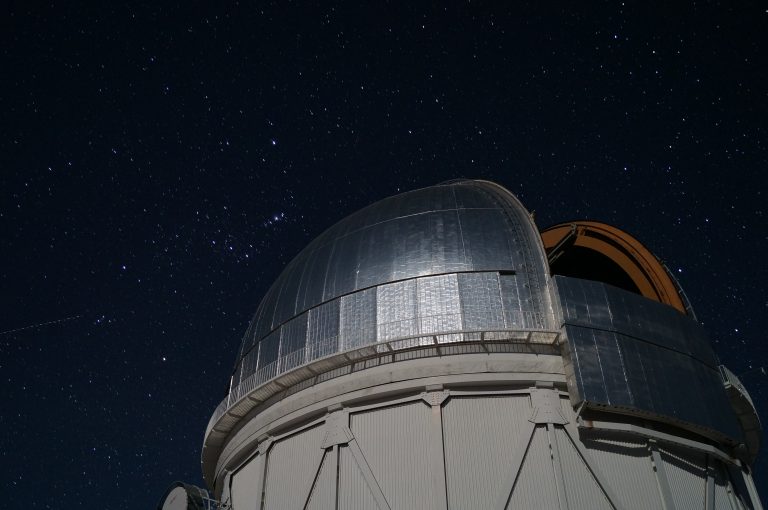
Although annoying when we want to image faint galaxies light years away, the moonlight gives a surreal lighting to the observatory.
Agnès Ferté, postdoc at NASA JPL
Memory: Blanco Telescope
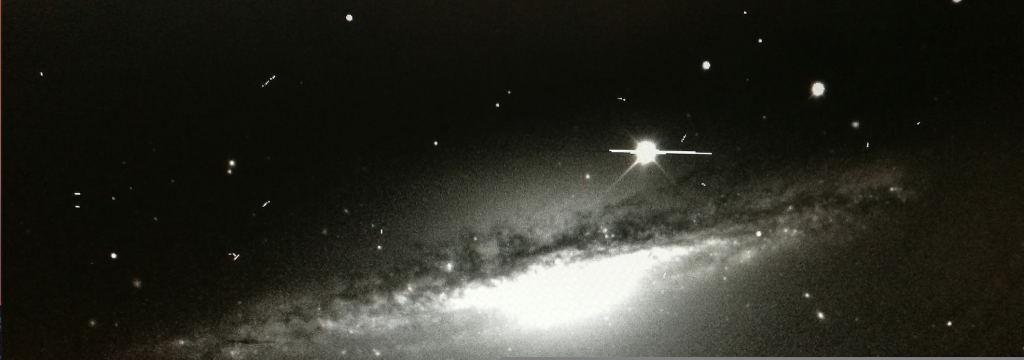
I kept an eye on the exposures as they came in to spot the beautiful foreground galaxies. We saw two parallel streaks right across one exposure. With simple trigonometry we ruled out aeroplanes. Our leading hypothesis is orbiting metal reflecting sunlight, really cool! (Streaks not shown in this exposure)
Benjamin Thomas, PhD Student at Portsmouth University Institute of Cosmology and Gravitation
Memory: Blanco Telescope
I had a wonderful Christmas last year at the Anglo-Australian telescope, for the survey OzDES (which performs spectroscopic follow-up for DES). We saw a Christmas rainbow, had a fantastic lunch at the telescope operators’ house, and had a special christmas cake and hot chocolate treat packed for us as part of our night lunch. And of course, we were joined by the many festive kangaroos and wallabies!
Elizabeth Swann, PhD Student at Portsmouth University Institute of Cosmology and Gravitation
Memory: AAT
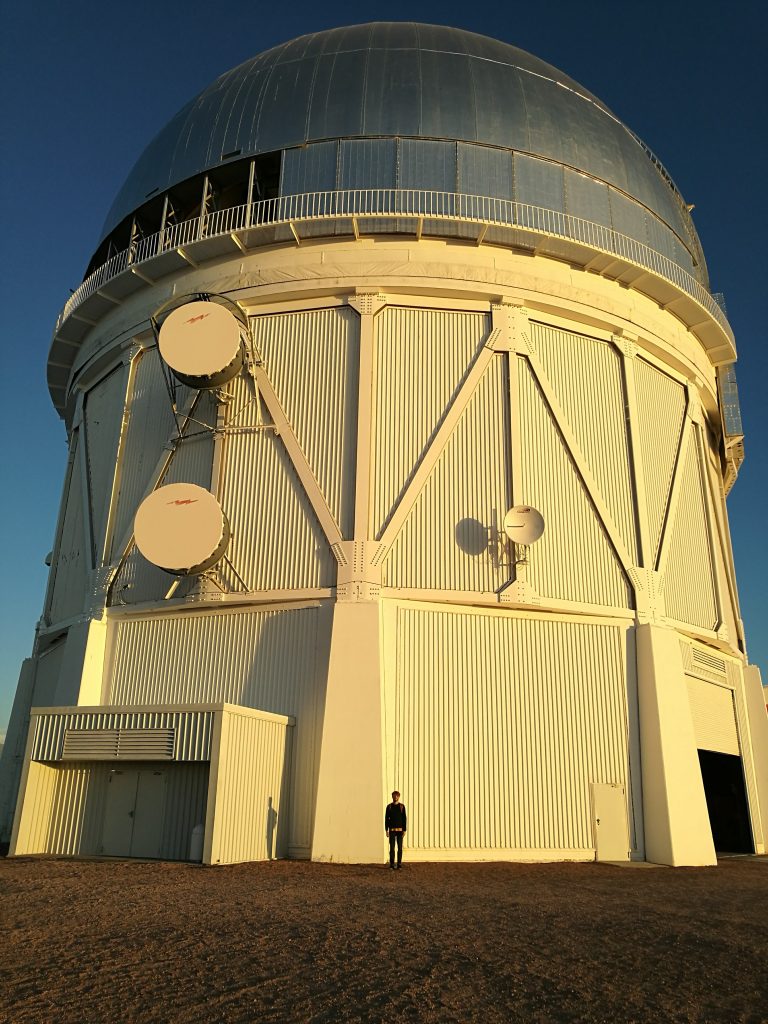
One thing that struck me on arrival was how absolutely huge the Blanco dome is. I had to ask my fellow observers to get a picture of me in front of it!
Benjamin Thomas, PhD Student at Portsmouth University Institute of Cosmology and Gravitation
Memory: Blanco Telescope
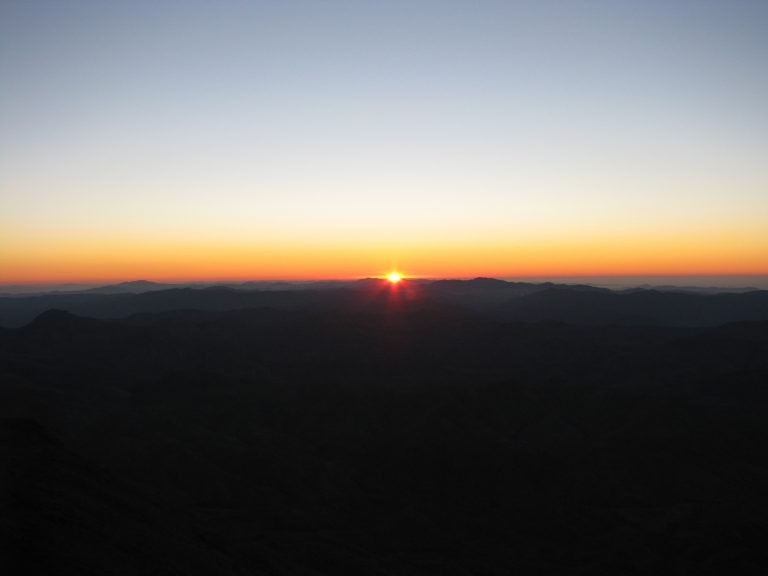
My best memories of observing for DES are of the sunset, as then it was almost time to start observing!
Matt Wiesner, Assistant Professor at Benedictine Universit
Memory: Blanco Telescope
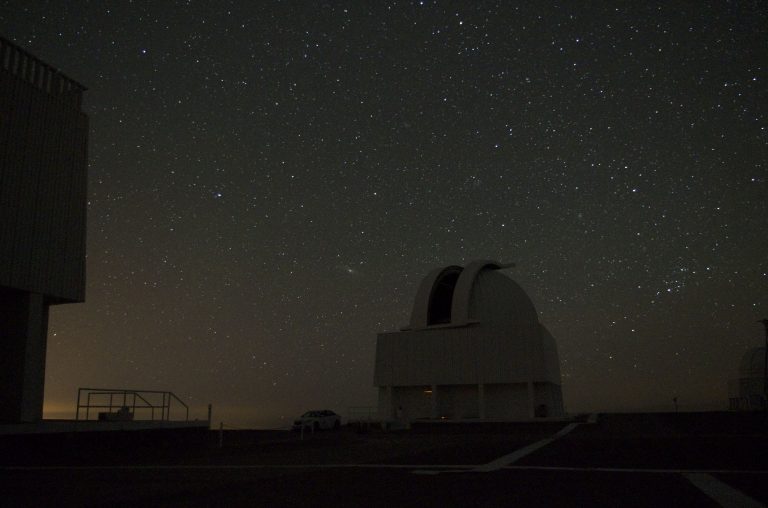
It had been a dream of mine for years to go observing at a telescope. The total darkness of the night sky on the mountain was unlike anything I had ever experienced. No artificial lights, no one around. Whenever I had a chance to go outside and just stare out at the sky, I was always enthralled. You really feel like a part of the Universe, when instead of seeing street lights, other people, or even the ground beneath you, the only things visible are the stars, tens to thousands of light-years away. Though I study the Universe every day, typically in an office, there is nothing quite like the experience of seeing a mountain top night sky.
One particularly exciting experience of my first observing trip was finding the Andromeda Galaxy. In college, my advisor told me that on dark nights, you can actually make out the Andromeda Galaxy with the naked eye. This always sounded like a fairy tale to me. I had gotten out into the countryside sometimes, but you just can’t see Andromeda. She said it had to be very dark, and you often could only make it out by looking a little away from it (this has to do with how the rods and cones in your eye work for detecting faint light). Having to play tricks with where you look to see it also gave finding Andromeda a sort of mythical feel to it.
On the mountain, I went outside to look for Andromeda. I knew where it should be on the sky, its relative position to the Andromeda constellation (of course, in Chile it had the opposite orientation to what I was used to in North America!) I looked at the point in the sky where it should be. I couldn’t really see anything. I then tried multiple times to look a bit offset from that location, and try to see it with my peripheral vision. I thought I could see something, very faint. I did this multiple times. I then tried this look and then look a bit offset trick on random points of the sky. Didn’t see anything. Was I really seeing Andromeda? That incredibly faint splotch I couldn’t even stare at directly? It wasn’t until I did this 3-4 days in a row that I convinced myself I really was seeing the Andromeda Galaxy, 2.5 million light-years away.
This is a long-exposure photograph I took of the Andromeda galaxy, the brighter object directly to the left of the top of the telescope dome, and directly up from the right edge of the car. You can see that it has a disk, unlike the rest of the stars, oriented about 10 o’clock to 4 o’clock.Ross Cawthorn, Research Associate at University of Wisconsin-Madison
Memory: Blanco Telescope
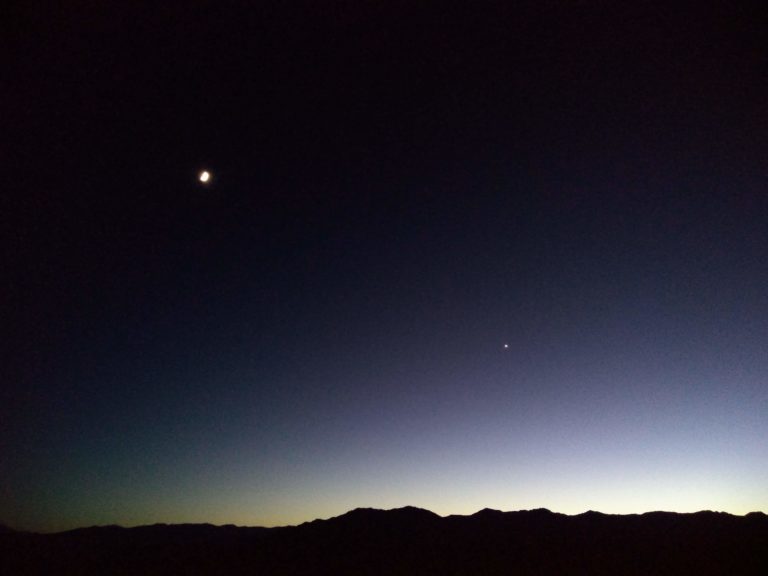
Stumbling down the mountain at 6 in the morning, so tired that we were shouting at Venus for being too bright! Photo: Moon (left), Venus (right).
David Turner, PhD student at University of Sussex
Memory: Blanco Telescope
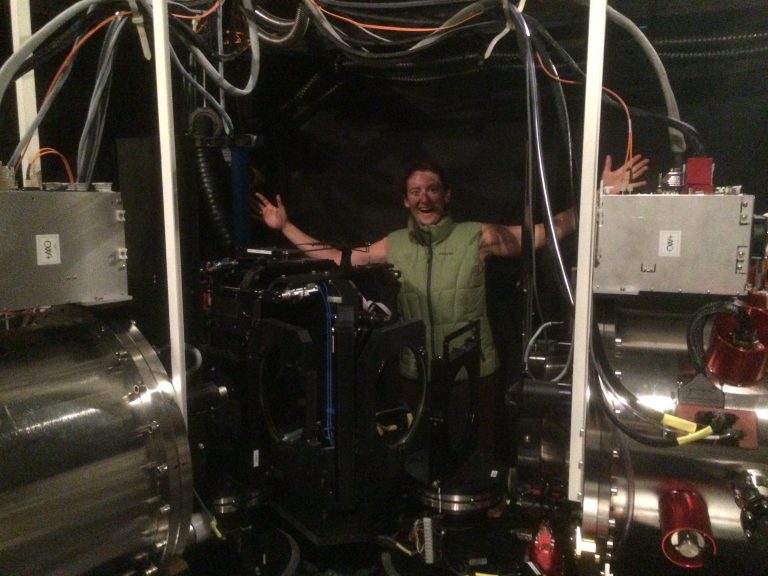
Below the shiny mirror in the deep dark depths of the (Anglo-Australian) telescope, is the spectrograph that does the real work of turning the light from galaxies into data we can analyse.
Tamara Davis, Professor at the University of Queensland
Memory: Anglo Australian Telescope
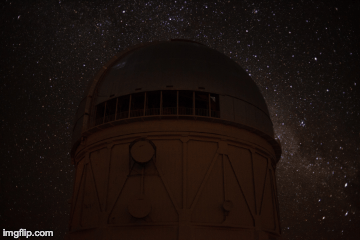
The noticeable quiet at the mountaintop is broken a few hours before sunset as the large dome of the Blanco creaks open. The telescopes look like guardians of the sky, perched on the summit: giant robots awakening almost at once in the fading light, following the lead from Blanco, the eldest and largest of the tribe. By nightfall, their eyes are wide, peering into the heavens. Throughout the night they rotate slowly and to their own rhythm, making sure not to miss a beat in any direction, protecting the cosmos from any trace of human invasion and light pollution. We creep around them with tiny flashlights in the dark, taking what we can to learn of our Universe.
Alexandra Amon, Kavli Fellow, Stanford.
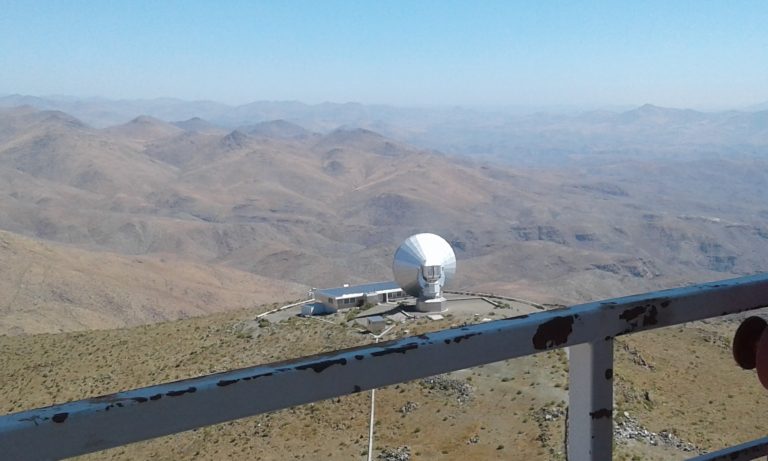
Seeing the Large Magellanic Cloud and the Small Magellanic Cloud for the first time with my own eyes was amazing – they just pop right out of the sky! This is a favourite image of mine taken at the close by La Silla Observatory.
Mandeep Gill, Staff Scientist at Stanford University
Memory: La Silla Observatory
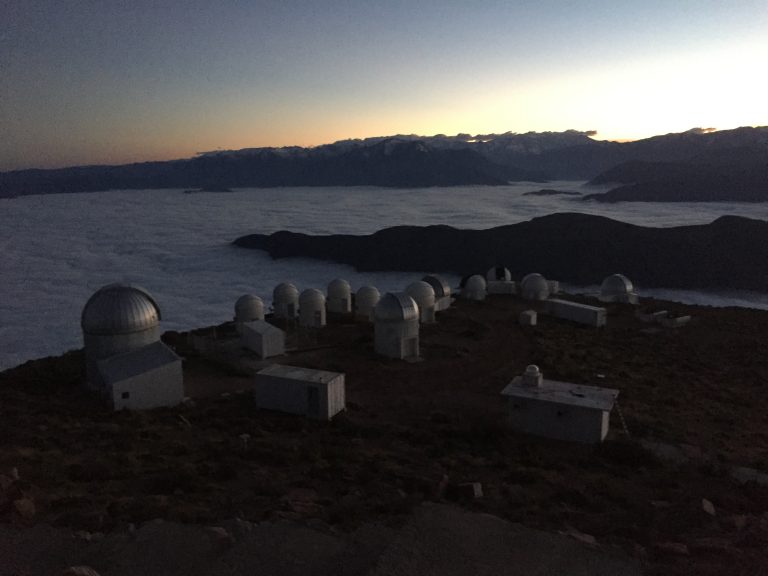
Ending your day at sunrise and enjoying the quiet, beautiful walk down the mountain.
Michael Johnson, Staff Scientist at the National Center for Supercomputing Applications
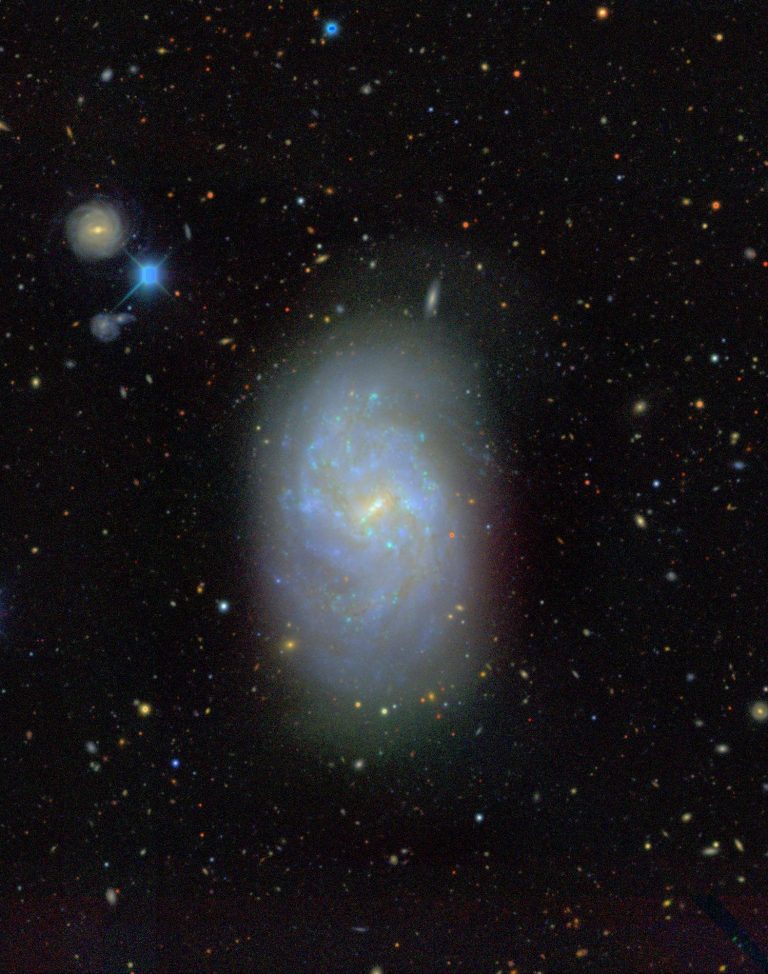
After dinner, with observations for the evening all prepared we walked up to the summit of Cerro Tololo in the clear dry air and watched the sunset and the mountain shadows. Then, late at night, we emerged from the Blanco dome and looked up to see the Milky Way, the Large and Small Magellanic Clouds, the ‘gate’ stars of Alpha and Beta Centauri and all the beautiful Southern Sky highlights.
Brian Yanny, Staff Scientist at Fermilab. (Image credit: Erin Sheldon)
Memory: Blanco Telescope

Working in the telescope control room at Cerro Tololo is always great!
Arnau Pujol, LENA Postdoc
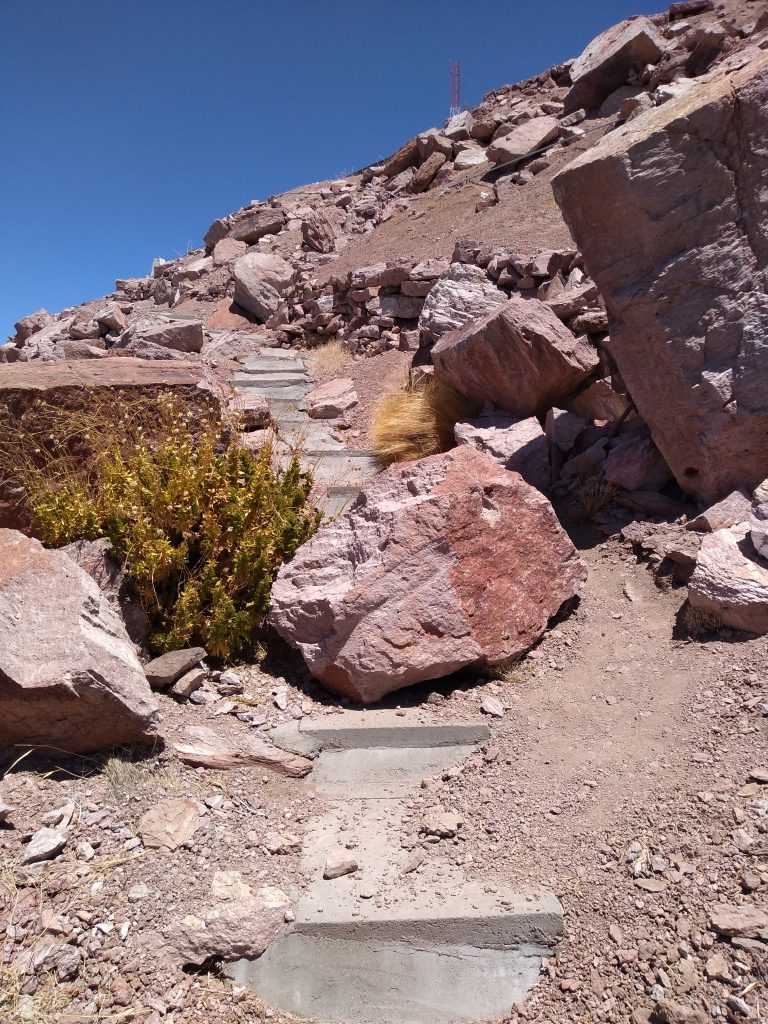
I can certainly remember my worst memory: earthquakes that followed the very large quake of September 2015. I arrived in La Serena, just 3 days after the very large quake. However my two DES runs were still fun, as I met new people and spent time with my graduate students. The photo shows a boulder that was dislodged during the earthquake and fell on the steps on the way to the Blanco.
Basílio Xavier Santiago, Professor at UFRGS. (Image credit: Sunayana Bhargava)
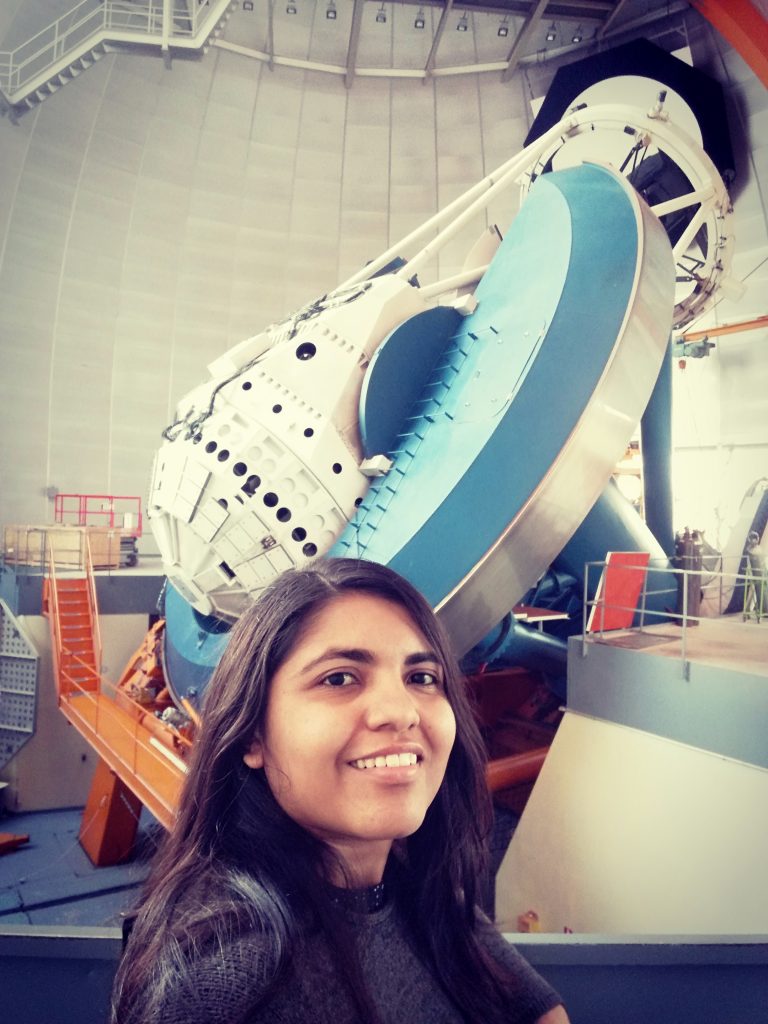
My favourite memories are those of the sunset, wild animals and the view of the mountains.
Maria Elidaiana da S. Pereira, Postdoc at Brandeis University
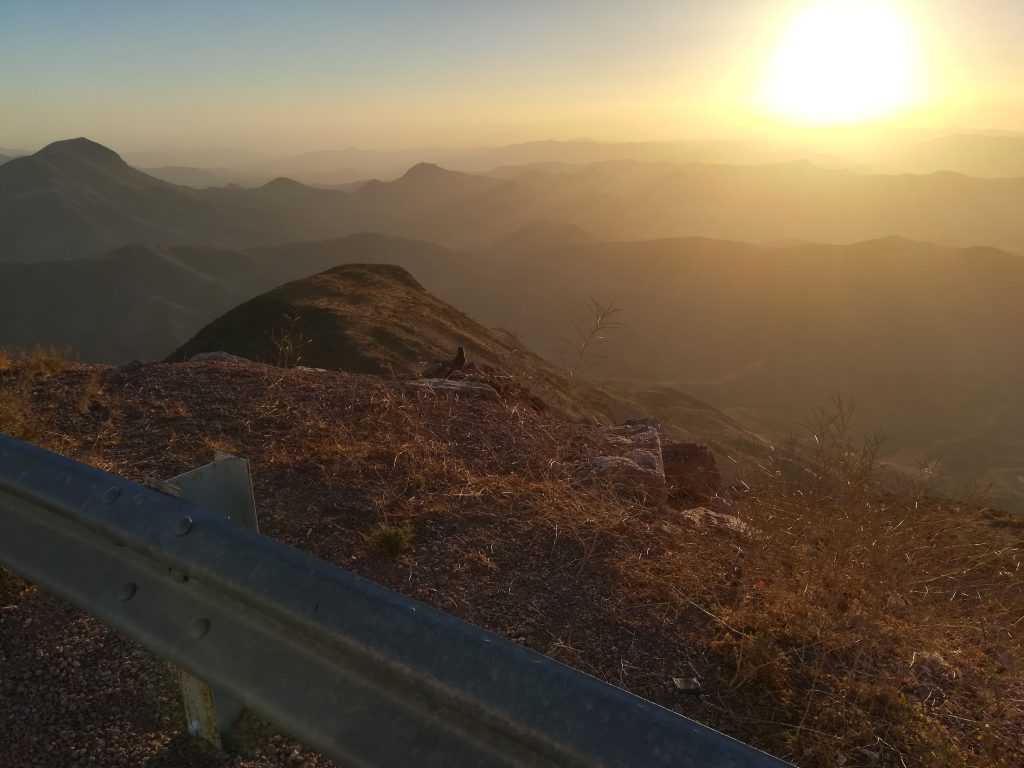
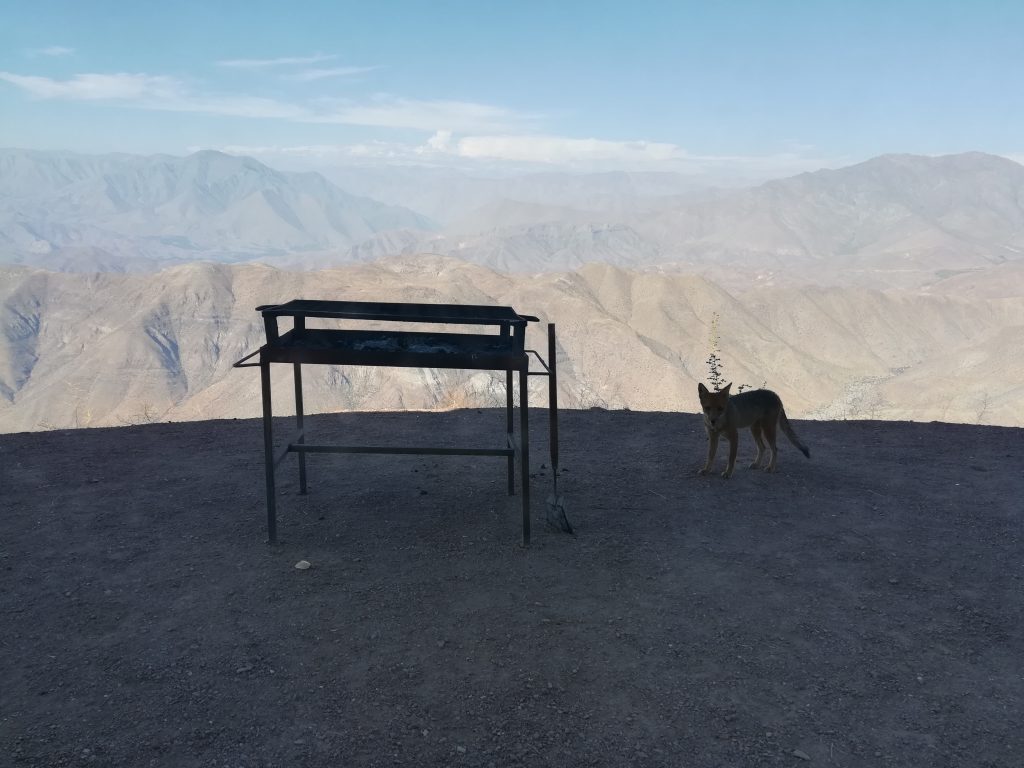
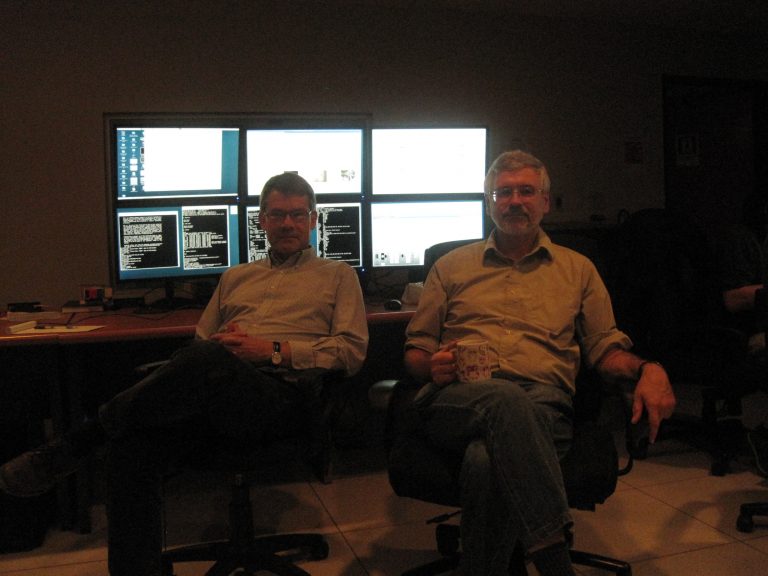
My first observing run with the Blanco telescope was around Christmas in 1976, when I was a graduate student, not too long after the CTIO 4-meter telescope (as it was then called) was open for business. My co-investigator, Hyron Spinrad, was unable to come (family vacation!), so I was alone in charge of the observing program (optical follow-up of southern radio galaxies). We were scheduled on the Blanco (prime focus and Cassegrain focus) and also on the 1.5-meter telescope. The run was five nights and was pretty exhausting in terms of learning how to use all those foci and their instruments. The prime focus is of course the most relevant for DES stories. At the time, the cage (the thing replaced by DECam) enabled one instrument, a direct camera with a 3-element corrector with a 50-arcmin field. The detector of the day was a photographic plate (about 1% quantum efficiency) that required exotic sensitizing rituals depending on the wavelength for which the emulsion was designed. Nothing was automated: the astronomer rides with the telescope and camera. Inside the cage you have your finding charts, a flashlight, a stack of plateholders, and something to sit on (at the Mayall telescope prime focus the chair was an old apple crate – I do not recall how the Blanco cage was furnished). The main task is first to find a guide star using a probe at the edge of the field. Then, during the one-hour exposure, keep the star precisely centered on a dimly lit crosshair using a handpaddle with buttons for the directions. Since the cage is otherwise dark, quiet, and vibrationless, your guide star is the main sensory input that you have for the night. Fortunately the nights were short!
Rich Kron, Director of The Dark Energy Survey
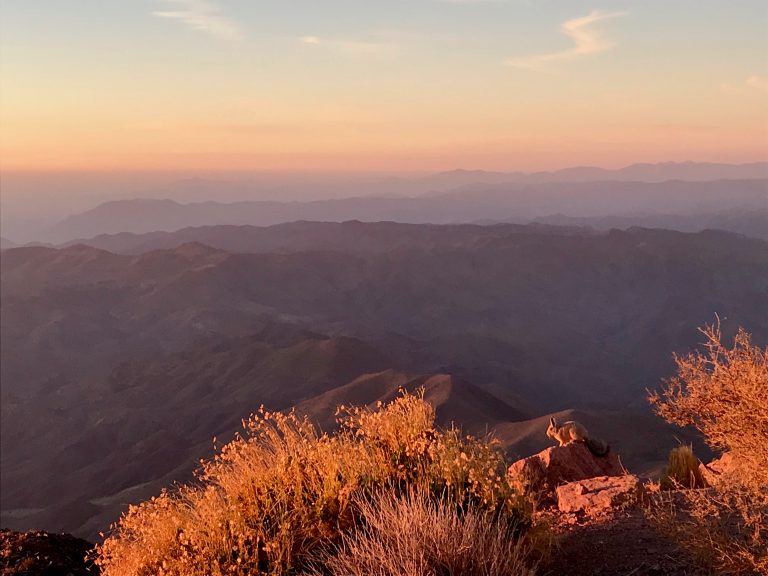
I like that we aren’t the only ones who watch the sunset up here.
Alexandra Amon, Kavli Fellow, Stanford

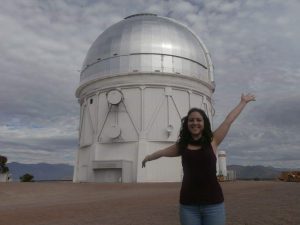
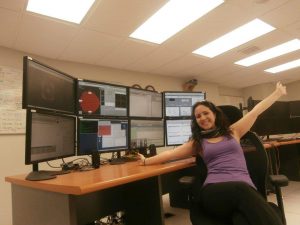
Three years ago I was doing my PhD in Madrid and had the chance to go observing for DES. The starry skies and the sunsets were amazing. The only problem I had was finding a scorpion in my bed one night! Traveling and discovering new places was the best part of my PhD. Three years later I’m travelling and doing scientific outreach around Latin America. @Acogeauncientifico (www.acogeauncientifico.com)
Ana Salvador
Memory: Blanco Telescope
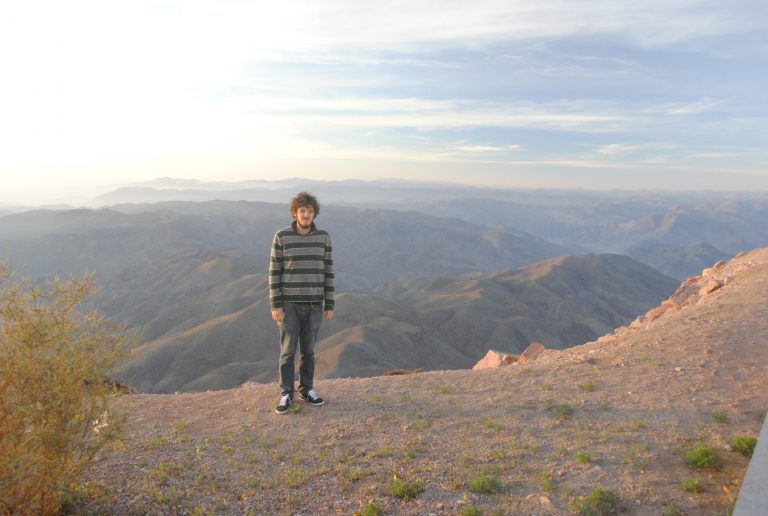
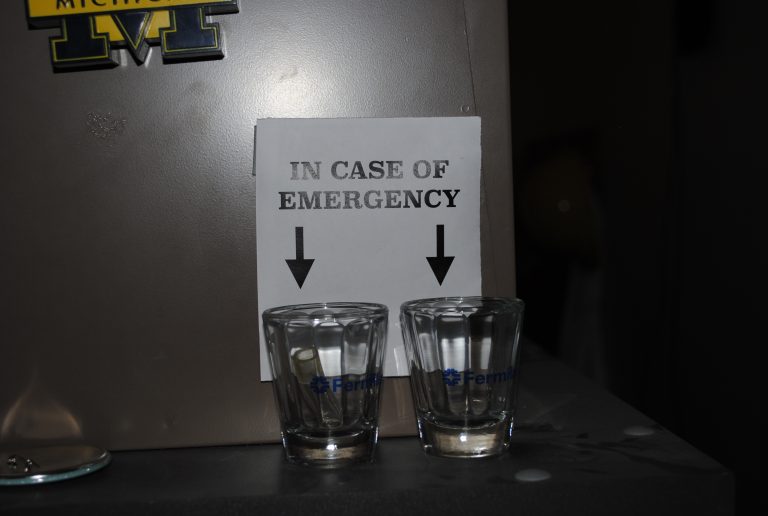
I have been a member of DES for over a decade! I joined in 2008 and now, the last exposures are being taken. I remember that I had a fantastic time when I went to observe at the Blanco telescope. First of all, seeing Cerro Tololo was incredible. A spectacular landscape with one of the most impressive night skies I have ever seen. I’m from Tenerife, in the northern hemisphere, so had never seen the Magallanic clouds – something I won’t ever forget (after that day, I have seen them a couple more times)
Aurelio Carnero, Postdoc at Observatorio Nacional
The control room at the Blanco telescope is superb, especially, their emergency kit! Earlier in my trip I had 2 days to explore Chile. I had one night in Santiago and then a day trip around La Serena and Valle del Elqui, a beautiful place, and famous for its wines! I love Chile, I have been very lucky to visit such a beautiful country with one of the best night skies in the world. DES did very well to set their basecamp there!
Memory: Blanco Telescope
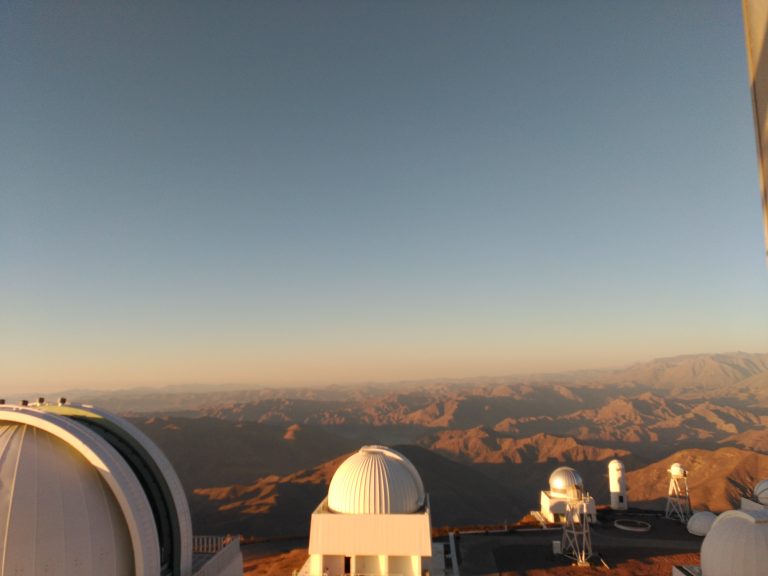
When I was observing at Tololo on December 2017, we used to have a look at the images coming in and see if we could find some galaxies. When we found a galaxy, I remember thinking that it was not at all like observing a star. Around a star there may be some planets. There are billions of stars making up a galaxy, meaning the images of them certainly contain a huge number of planets as well. This made me think about whether there could be a civilization like ours in any of these imaged galaxies. If so, we, in our Milky Way galaxy, could be just an image of a galaxy contained in the footprint in an alien surveys. This makes me feel small and humble, and it reminds me that all those dots of light in our galaxy photos are really much more than just that.
Martín Rodríguez Monroy, PhD student at CIEMAT, Madrid
Memory: Blanco Telescope
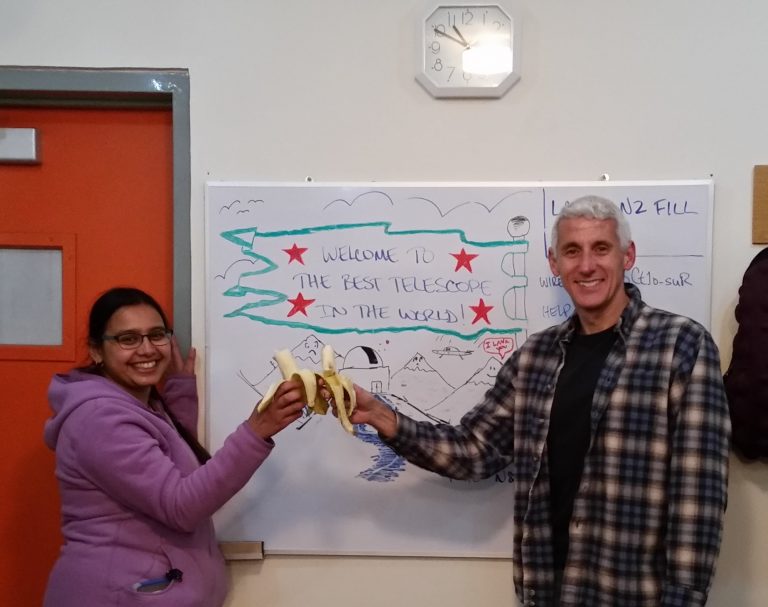
Going observing means meeting astronomers from all over the world – and learning fascinating observing/telescope traditions! From Prof. Todd Henry of RECONS I learned about the banana hour – if one observer from each active telescope eats a banana between 10-11pm, it’ll be a good, clear night, perfect for looking into space!
Rutuparna Das, UM Dept. of Physics
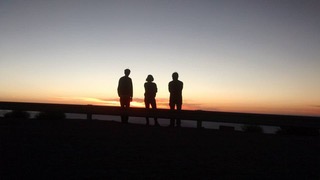
It is customary for the observers to wander outside to watch the Sun go down before the night starts. Todd Henry captured a beautiful photo of our shift team (Jim Annis, Benjamin Thomas and myself) watching the sunset at CTIO.
Rachana Bhatawdekar
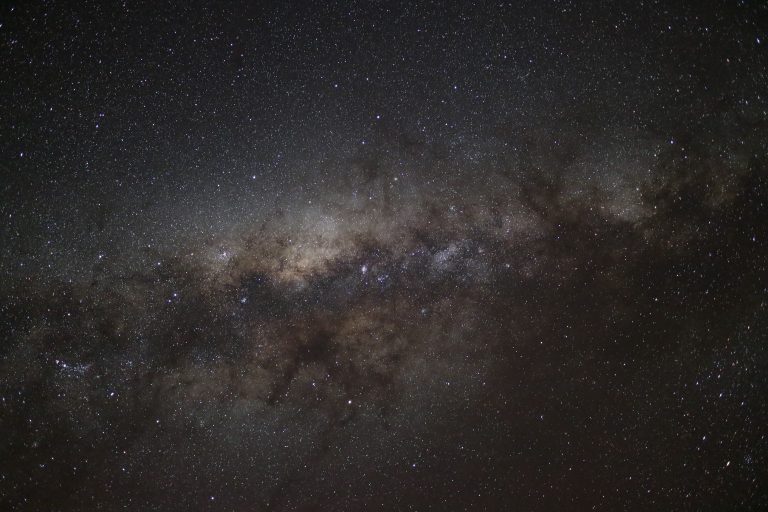
I made six observing trips for DES, and each one provided special memories. Celebrating the New Year with the staff and their families, drinking wine as we watched the fireworks go off across the Elqui Valley. An epic 13-mile run from Cerro Pachon to Cerro Tololo. Discovering a scorpion in my bedroom. But my most treasured memory is a simple one: stepping outside the dome on a moonless night, into darkness so complete I couldn’t see my hand in front of my face. Raising my arm and seeing a hand-shaped hole in the stars. My eyes slowly adapting to the darkness, allowing the most pristine skies on earth to open up above me. Stars showing their colors and appearing almost three-dimensional. The Milky Way ablaze from horizon to horizon. Eventually I went back inside to resume my shift work. By the time I came back outside, dawn had washed the stars away. But now, wherever I am, I can look up and remind myself that those stars are still there.
Prof David Gerdes, University of Michigan. Photo by Eduardo Balbinot.
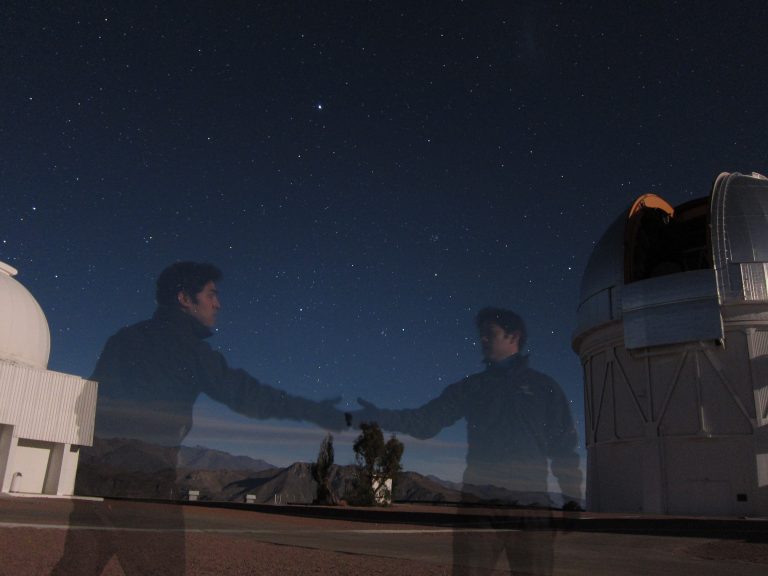
Observing for DES Y3 gave me the opportunity to meet friendly and funny DES colleagues and (thanks to a bright moon and double exposure photography) to even meet myself!
Ravi Gupta, Postdoc, Argonne National Laboratory
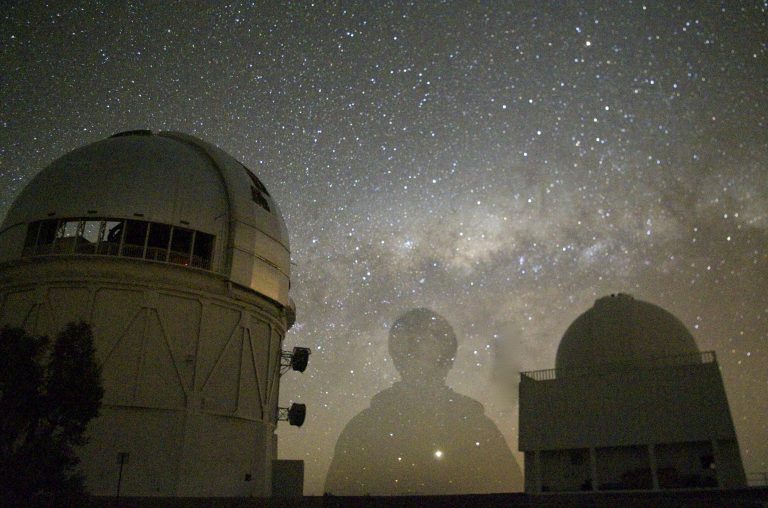
On the mountain, with so many stars visible, you can’t help but feel like a part of the Universe.
Ross Cawthorn
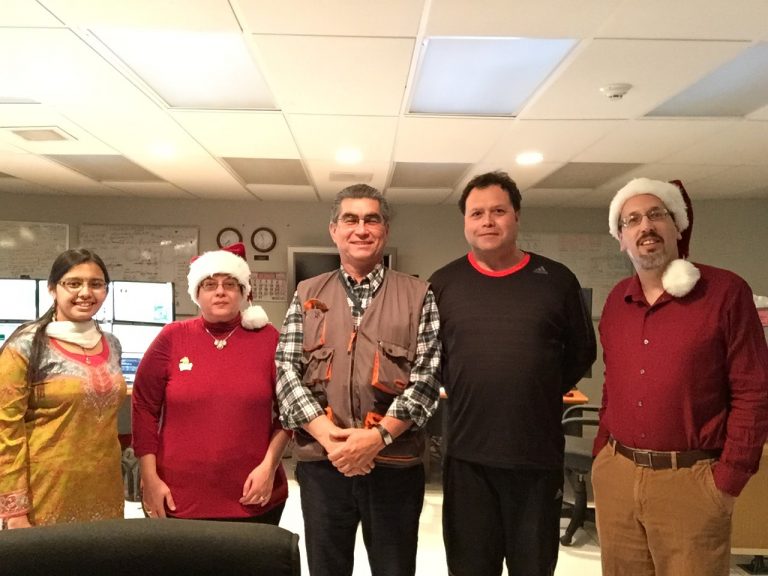
One of my best memories of DES observing was observing over the December 2014 holidays. Here is a photo of the DES observing team on Christmas Eve, 2014 (left to right: Rutu Das, Sahar Allam, Hernan Tirado, Alberto Alvarez, Douglas Tucker).
Sahar Allam and Douglas Tucker
In the middle of The Australian bush, there is an amazing telescope that gets supernova and galaxy spectra for measuring the expansion of the Universe #OzDES
Anais Möller, Postdoc at the Australian National University
When I go observing at the AAT for OzDES, I am always fascinated by this robot that places 400 fibres to catch up the light of galaxies far away. I went observing during one of the last OzDES runs at the AAT in Australia. It was both exciting and sad at the same time. We have been observing in this amazing place with the kangaroos for 5 over years!
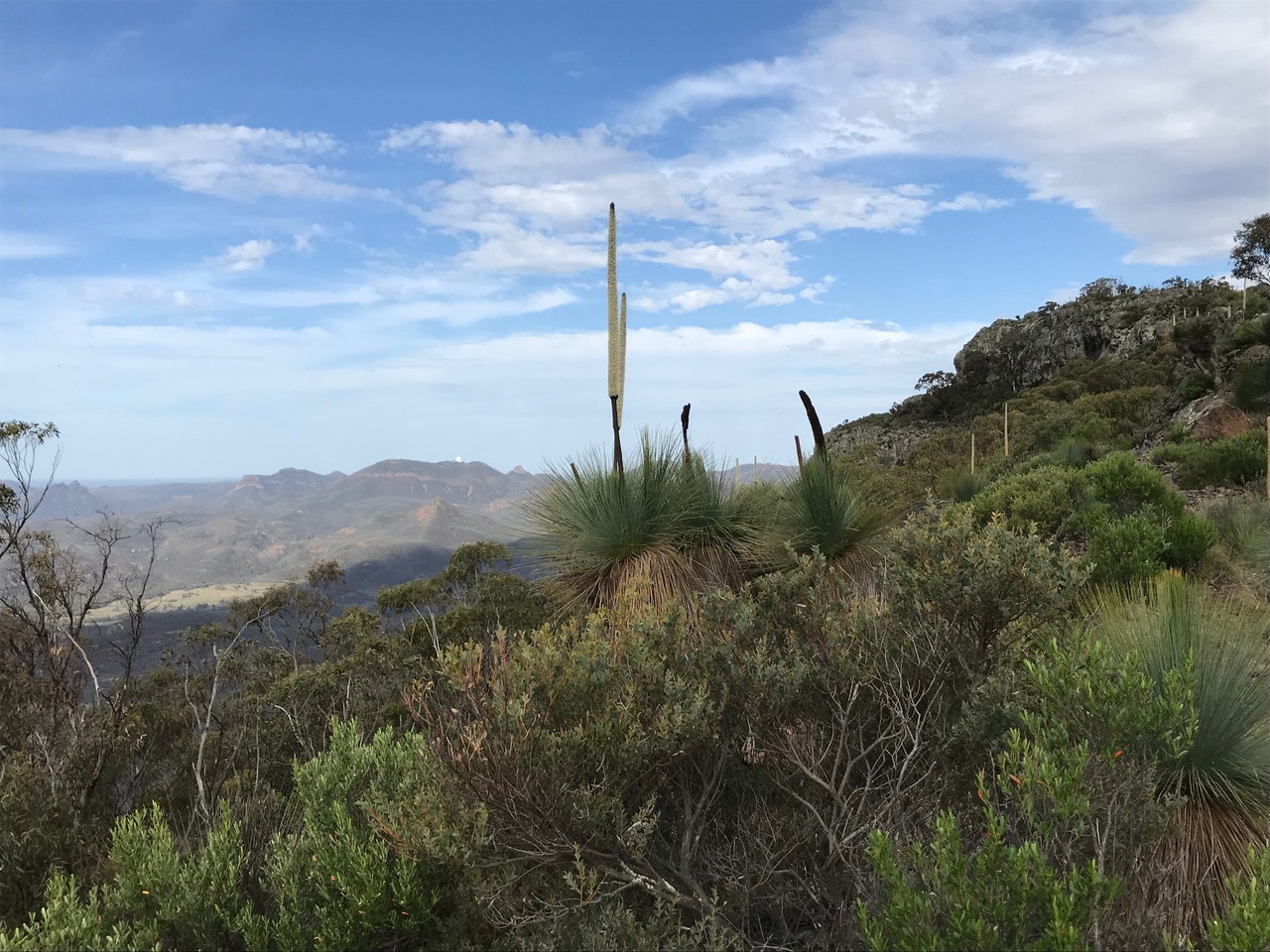
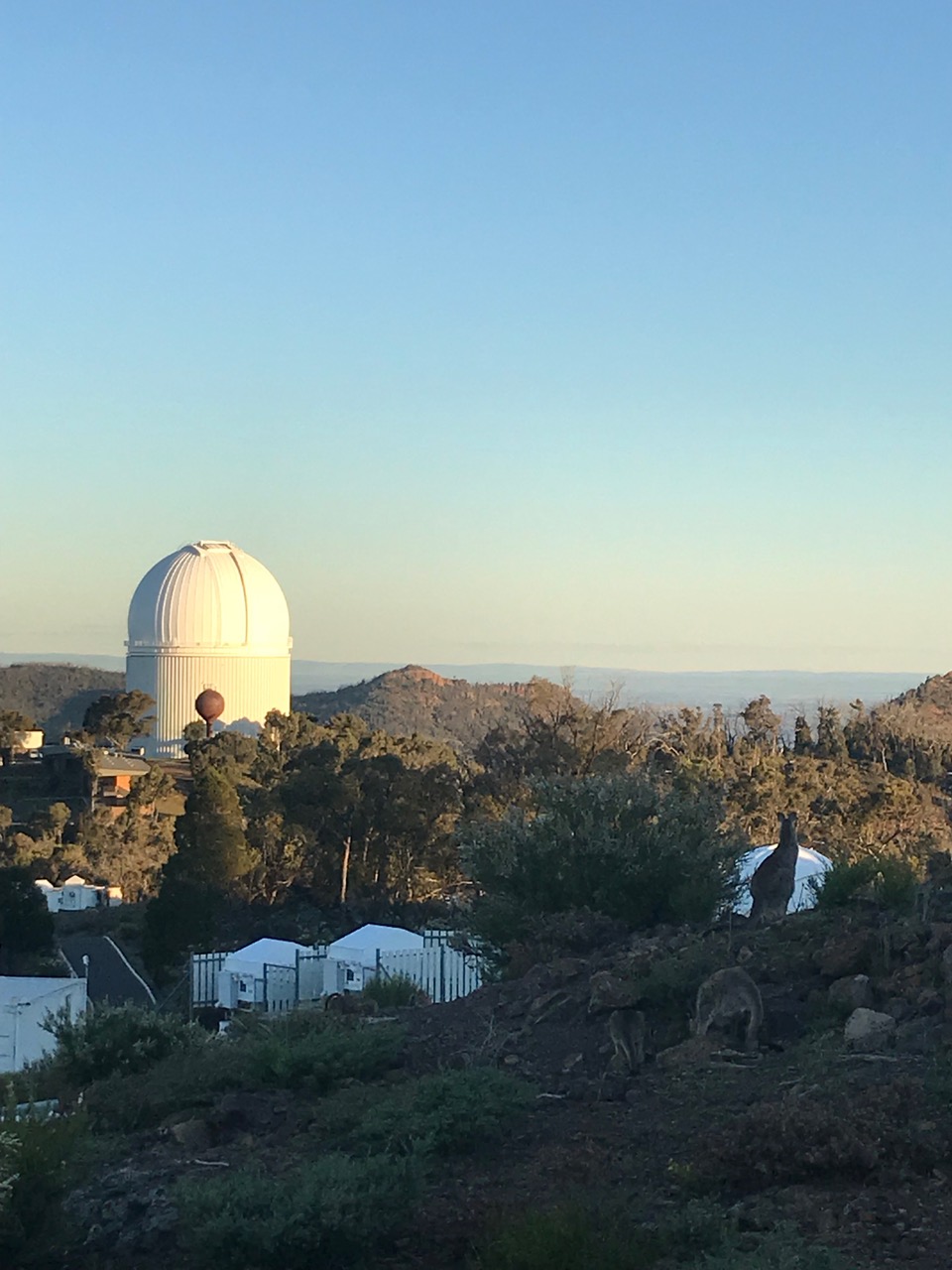
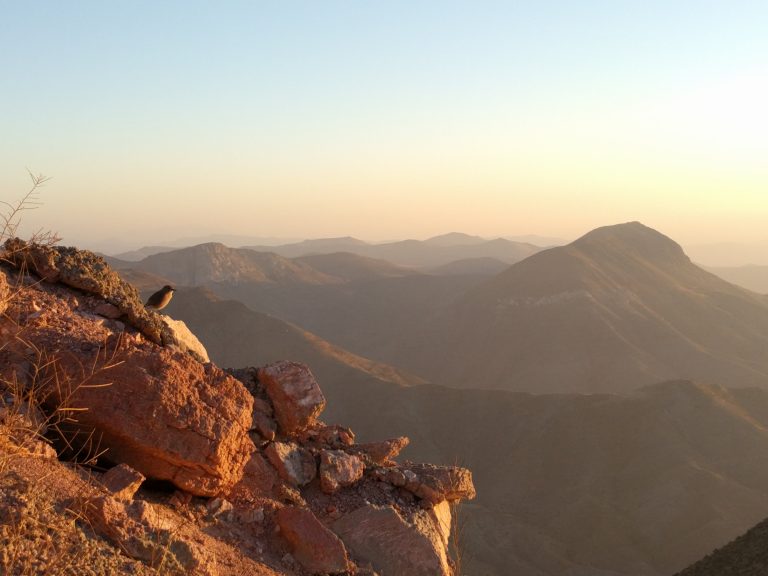
I’ll miss sharing the incredible Chilean sunsets with the wildlife on Cerro Tololo, like this little bird perched on its overlook. It’s almost fitting that my PhD graduation year coincides with the last year of DES operations!
Stephanie Hamilton, PhD student at the University of Michigan
Watching the last sunset of the final observing run for DES, realizing how big the Blanco telescope is, watching the sunset with a family of viscachas, looking for the green flash and breaking the DES push-up record! Rich taking us inside the telescope.
Robert Morgan, University of Wisconsin-Madison
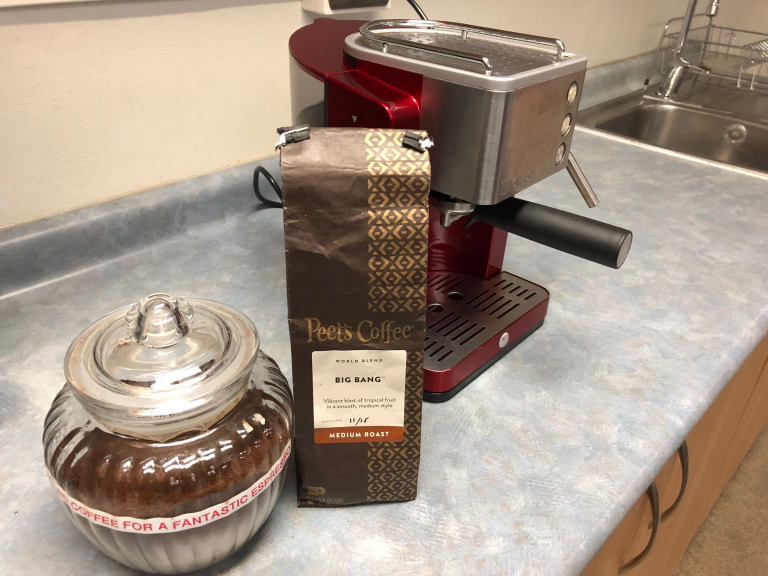
Dark Energy Observers control the camera and telescope and mind the data quality from sunset to sunup. Naturally the observers prefer coffee that has dark energy of its own.
Tom Diehl
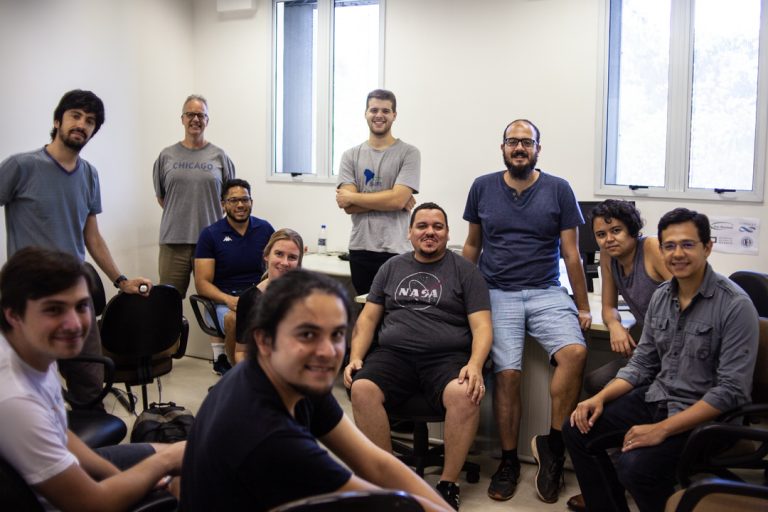
During the week of December 10 2018, Elisabeth Krause spent her time at the ICTP South American Institute for Fundamental Research in Sao Paulo to boost the productivity of our group in the covariance effort for the DES Y3 Results. It was great fun to participate in and enjoy this collaborative endeavour!
Rogerio Rosenfeld
When I was asked for my best memories of observing for DES I struggled to answer. I have so many. I went 3 times, but even if I’d only been once I would have struggled. Observing for DES has not only been the highlight of my career, it has been a highlight of my life. Many of us science nerds struggle to fit into the regular world, but when I am at CTIO I genuinely feel that I’m home.
Kathy Romer
With less than 24 hours to go before the last observation is gathered for DES I am feeling sad (about what we are saying goodbye to) rather than jubilant (about what we have achieved). None the less I am in awe of the fact that this seemingly impossible experiment has defied (at least my own) expectations and finished successfully. Maybe not “on time” (we are about a year late), but (as far as I know) we were “on budget”. Yes it was a big budget, but figuring what this crazy Universe of ours is doing is an expensive problem to solve!
Here are just a few things I remember about observing….
The sign when you first approach the dormitories: it has a UV warning scale of 1-11. As far as I can tell it is permanently on 11.
The vegetarian options in the cafeteria. The quality is binary. Either there is specially prepared plate waiting for you: complete with a beautiful and delicious avocado fan. Or you have to make do with whatever isn’t meat/fish infused: one time I found myself with 5 different carbohydrates and nothing else.
The cookies in the night lunch. You get a full packet each night. There are at least 6 different varieties to choose from. My favourite are the galletas de champaña – which we’d call trifle sponges in the UK.
The fact that it is so darn hard to stay awake for the first 3 nights (there is photographic evidence of me crashed out on the sofa by the loos with eye mask on). But by the 5th night, it is breeze to pull off a 16 hour shift in the dome. The problem then becomes getting to sleep after dawn, especially when tanked up on coffee.
The fact that the toilet in my dorm room was filling with hot water: any time I sat down I would scald my back.
That weird time in the middle of the night when time seems to standstill. Not in a bad way. In fact it is the time when one gets the greatest sense of peace and/or fun. I recall many silly activities including a intense poker game in the break room when the stakes were night lunch sandwiches: money has no value on the mountain, the only currencies of importance are food, sleep, and the atmospheric seeing.
Being there during a meteor shower. I went outside for a quick check on the weather and became bewitched by the streaks in the sky. I must have been there for over an hour and didn’t realise what strain that was putting on my neck. It took three trips to the chiropractor to sort out.
The noises of the dome moving, and of the nitrogen pump. Those sounds are impossible to describe, but they surround you throughout your shift and bury into your psyche.
Visitors. There are surprising number despite the remoteness of the location. The best was a coach load of young kids from Southern Chile who invaded the control room one afternoon. They were adorable. They gave us hand drawn pictures of birds from their region that were mounted as fridge magnets. I have mine in pride of place in my office. We also had a visit from the American ambassador to Chile. She was really cool. She should be president!
Coming back is hard. I remember unpacking and finding my shoes still caked in the red sandy dirt of the mountain. It made me feel really homesick.
What I remember most of all about observing for DES is smiling. A lot
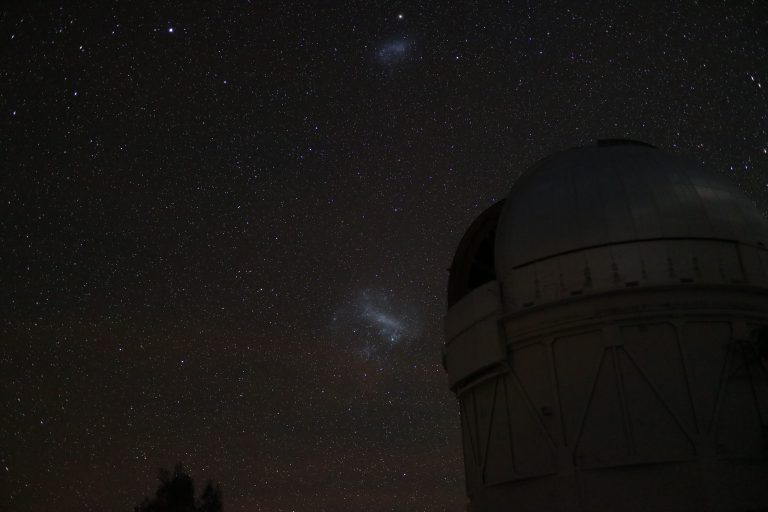
December 16, 2012. I’m sure I remember everything about that night as if it were yesterday. It was my second night of observations during a shift that was 8 nights long. My co-observers were Jim Annis, Ken Patton, and Bob Armstrong. This was during “Science Verification”. We took sequences of images of what ultimately became the DES “Supernova” fields E1, E2, X3, & C1 to C3. That night we had some trouble with the image quality, and I spent much of my time that night studying what we called “Guider Oscillations”, which caused the images to blur in the RA direction. The cause of the problem was diagnosed in January 2013. It was related to excess friction in the RA bearing. At the end of the night we took some fine exposures of the globular cluster known as Omega Centauri. You can see this object by eye from Cerro Tololo on a dark night. It looks like a blurry splotch a bit smaller than the full Moon, but not nearly as bright. I finished up my shifts on the morning of Dec. 23rd. I was very happy that David James (CTIO) did the observing that finished on Christmas Eve.
Tom Diehl. Photo by Eduardo Balbinot.
Tonight (Dec. 12-13, 2018) is my last night of observing for DES, which is very close to finishing its survey of the southern sky. Conditions are good, and the exposures from the Dark Energy Camera are rolling in. After 6 years of observing and 9 years of planning and building before that, coming to the end is bittersweet. Just before sunset, I went up into the Blanco dome to say goodbye to the Dark Energy Camera (DECam) and the telescope that together have performed so well—taking tens of thousands of images of hundreds of millions of galaxies for us—thanks to the dedicated efforts of many people in the DES collaboration, the engineers, technicians, and computing professionals at laboratories around the world, and the outstanding staff at Cerro Tololo.
Josh Frieman
Attached are a few memorable images from this observing run: the incredible view from the Observatory dining room that I will never forget; the exotic desserts that unfortunately (or actually fortunately) I can no longer eat; a sunset poetry reading by visiting poet Amy Catanzano, who is writing a series of poems on dark energy; and the Dark Energy Camera–the black cylinder perched atop the Blanco telescope, ready for another night of great data.
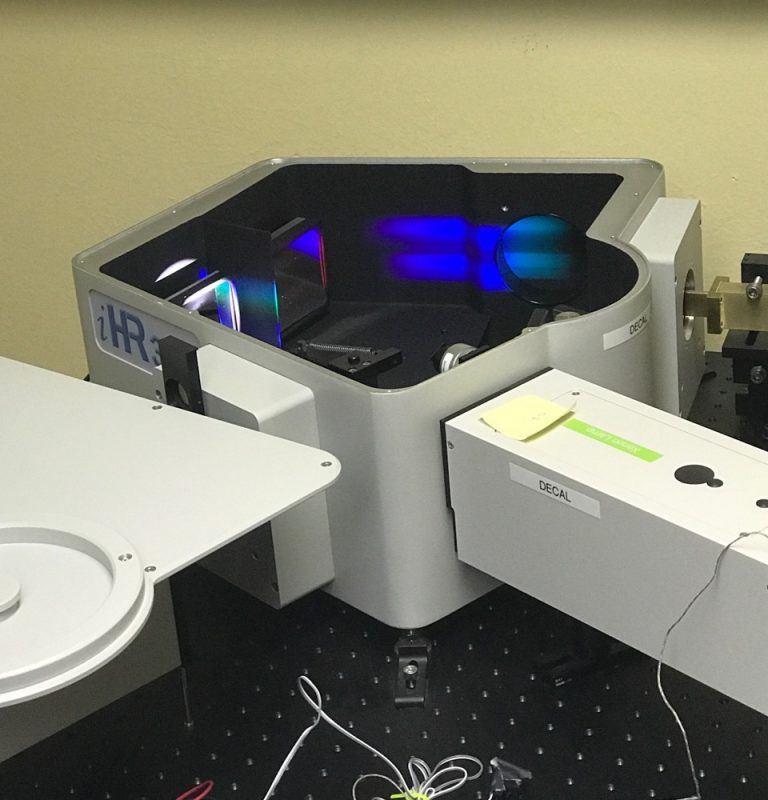
Even cloudy nights are busy time for the Dark Energy Survey. If the conditions of the sky are not good enough to open the dome, like yesterday night, we scan our filters. To do this, we have DECal, the DECam Calibration System, which contains a spectrophotometric calibration system that is used to measure the relative throughput of the complete telescope + instrument system as a function of wavelength and position on the focal plane. These scans allow us to monitor any change in the overall throughput of the system.
Kathy Vivas
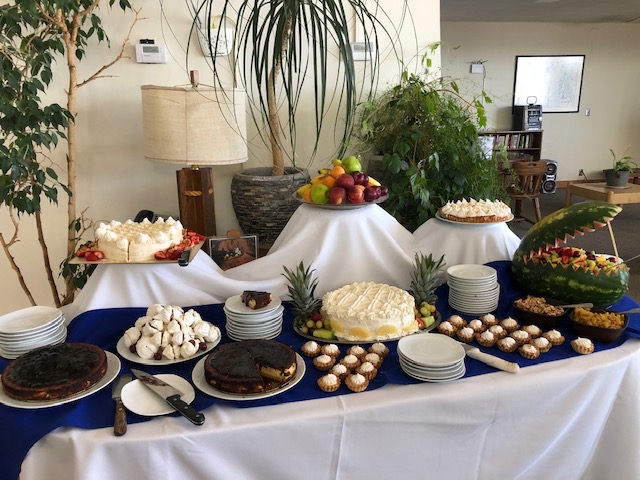
We had a very special end of nights lunch at CTIO today!
Kathy Vivas
What do viscachas (the Andean hare) think about? The astronomers tend to watch the sunsets at CTIO before starting in to the night of work. There are almost always a few viscachas sitting on the rocks below us also watching the sunset. Are they also contemplating dark energy? Cosmology? Or, just trying to figure out what the crazy humans are doing.
J. Allyn Smith
This year was my fourth traveling to Chile to observe for DES. I’ve spent a little over a month total at the telescope, and I’ve loved every minute of it! I’ve seen a bunch of amazing wildlife (viscachas, culpeos, scorpions, and tarantulas), I’ve seen a bounty of beautiful sunsets and green flashes, and I’ve seen truly breathtaking night skies. I’ll always be thankful to DES for the opportunity to be involved with telescope operations, and to the local Chileans for their telescope expertise, their friendliness, and their patience with my Spanish. I wish DES was going another six years so I could observe more!
Devon Hollowood
I was observing in Y2,Y3,Y5. I miss Y4 observing due to health problem, but going to observe in Y6. Two thing are inspiring to me: the opportunity to meet and work with new wonderful people, and the magnificent night sky on the mount top. Attached are some photos from my observing seasons and one viscacha that was kindly posing for me.
Nikolay Kuropatkin
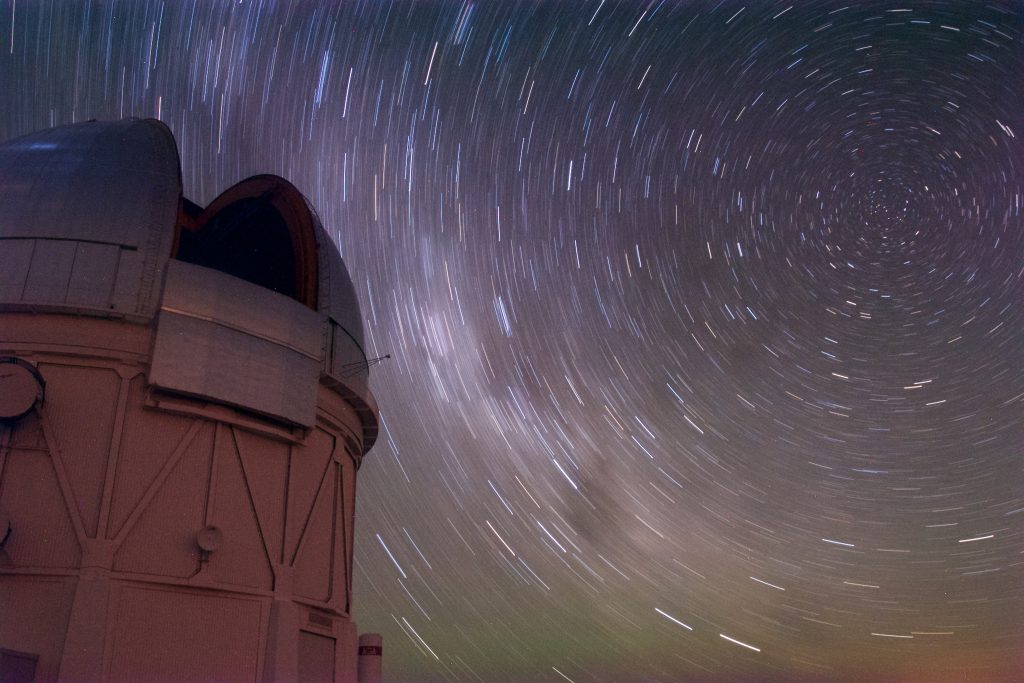
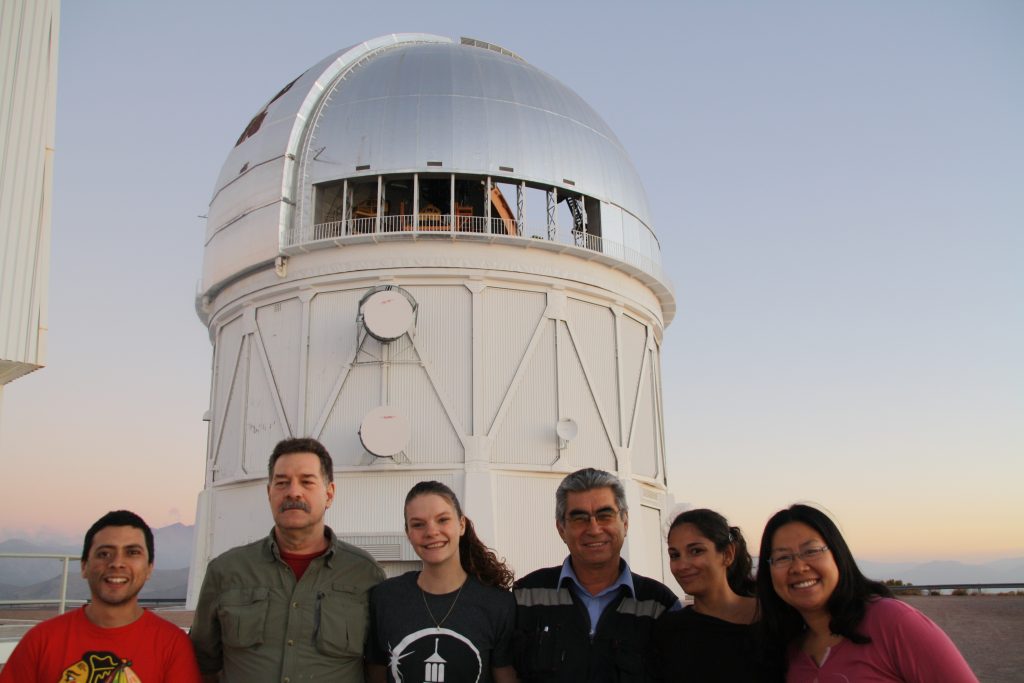
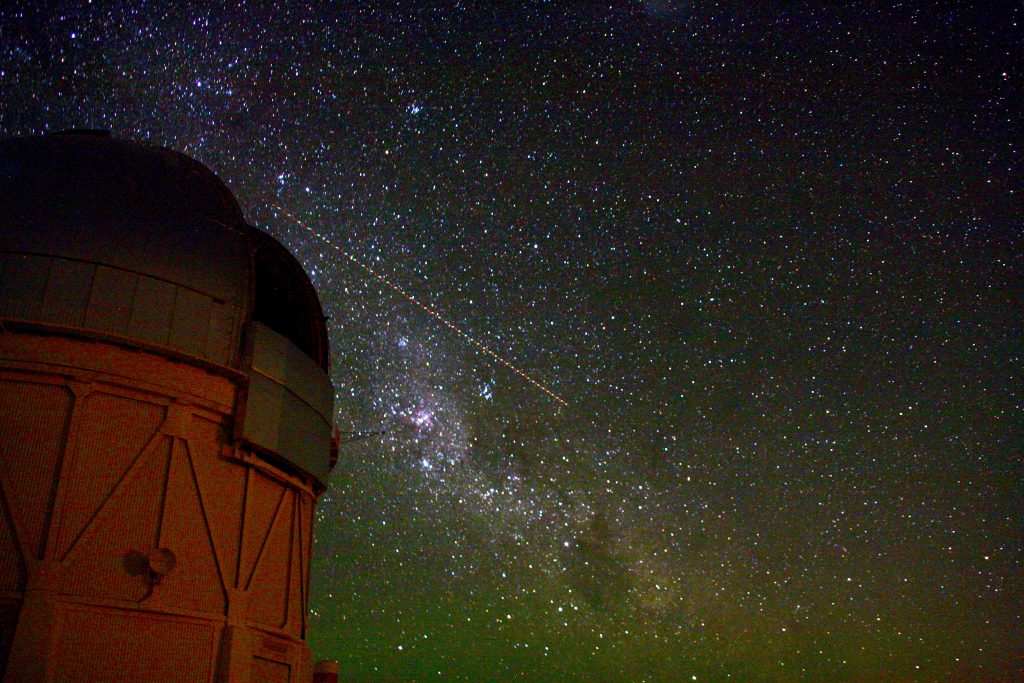
Our Favorite Sightings
Rutuparna Das
(to the tune of “My Favorite Things”)
Faraway galaxies, perhaps distorted,
Galaxy clusters by massiveness sorted,
Transient Type-1a supernovae –
These are the objects for which we survey.
High-richness clusters and galaxy spirals,
Snapshots of Lovejoy that kind of went viral,
A trio of galaxies merging in dance –
These are exposures that hold us entranced.
Constraints on cosmology – the stuff of our dreams!
Dwarf planet DeeDee, and bright stellar streams,
The first ever visible GW source –
These are a few of our favorite scores.
When the night wanes,
When DECam sleeps,
No more data to add –
We simply remember these wonderful years,
And then the end’s not…so bad.
My first trip in 2016 was exciting. The mountain lost power on my first day there. The outage went several hours and was made worse because a second outage was needed to repair a problematic switch. So my first two nights observing were spent waiting for power and a functioning telescope. On the third night we discovered that the hexapod was not working properly – the problem was a consequence of the previous two power outages. We spent a few hours on the Skype talking with Alister, who was in the UK. I think we took the blurriest image in the history of the DECam.
Marty Murphy
In general the things I’ll remember most fondly are the very kind people who keep CTIO running – from the chefs in the kitchen to the folks in the administration building to the outstanding Tel-Ops. I always felt like a welcome guest. I’ll remember the Saturday tour groups (see image) who make the observers feel like pop-stars by posing for selfies, etc. I’ll miss the delicious meals that were made with care and were every bit as good as the vista from the dining room (see image).
I very much enjoyed working with Nikolay Kuropatikin, Brian Nord and Brian Yanny to make produce the large DES images that were featured in the Fermilab Art gallery. I had three great trips with Ann, Allyn, Dillon (2016), Brian Yanny & Mandeep (2017) and Nikolay and Larissa (2018); I learned a lot from all of my fellow observers. I appreciated the conversations with Tom and Brenna about the aims and goals of the survey and the opportunity to be a small part of it.
And I look forward to the great results yet to come!
Looking at the Southern Cross again reminds of a summer I spent in Australia – one night I used that constellation to navigate home on my bike towards the south suburbs of Perth.
I’m amazed by the glow of the Milky Way as seen from the top of Cerro Tololo. The two small blobs next to it are the Magellanic Clouds. Curiously, if you look directly at them, you stop seeing them, only when focusing in on other nearby objects can you clearly spot these two dwarf galaxies.
Santiago Avila, University of Portsmouth
Here is a photo of one of the sunsets from our time on the mountain. One of the hardest things now that DES observing is coming to an end is not being able to see these kinds of wonderful views! Light drawing by shining a light through your hand!
Reese Wilkinson, University of Sussex
My favourite memories of DES observing include the incredible mountain views, viscachas and foxes, and probably best of all getting to spend time chatting about cool science and life with lots of other DES scientists on long observing runs. And (almost) curing my arachnophobia after being face-to-face with a tarantula in the canteen during a power shutdown…
Lyndsay Old, Research Fellow at ESAC
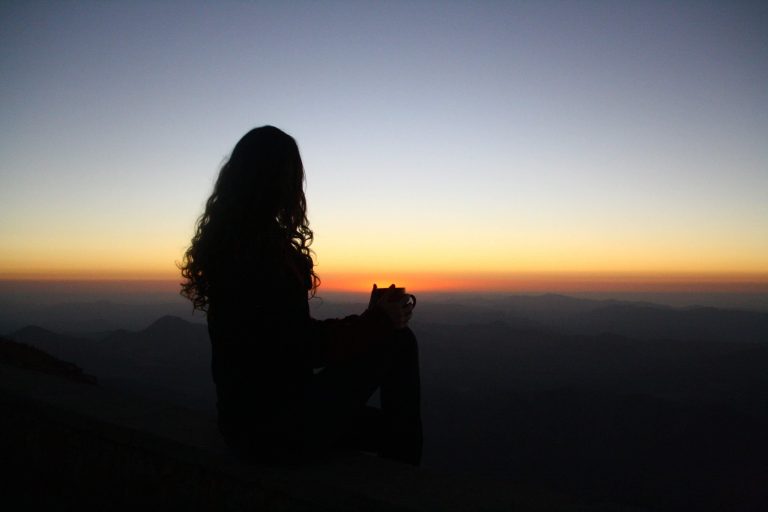
A cup of sunlight is the best beginning to an observing run, followed closely by a cup of coffee. I’d never before experienced anything as peaceful as sipping on a warm mug of coffee and watching the sun set over the mountains from the top of Cerro Tololo. What an incredible opportunity it has been, to observe for such a wonderful group as DES.
Deborah Gulledge, undergraduate at Austin Peay State University
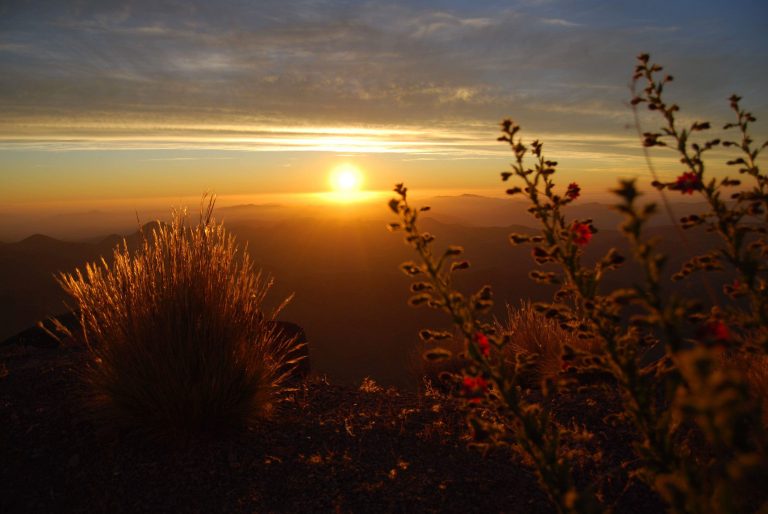
The colors of a sunset over the Andes and the plants growing all over the mountain are the closest thing I’ve ever seen to magic — right alongside the secrets of the universe that we uncover through DES.
Deborah Gulledge, undergraduate at Austin Peay State University
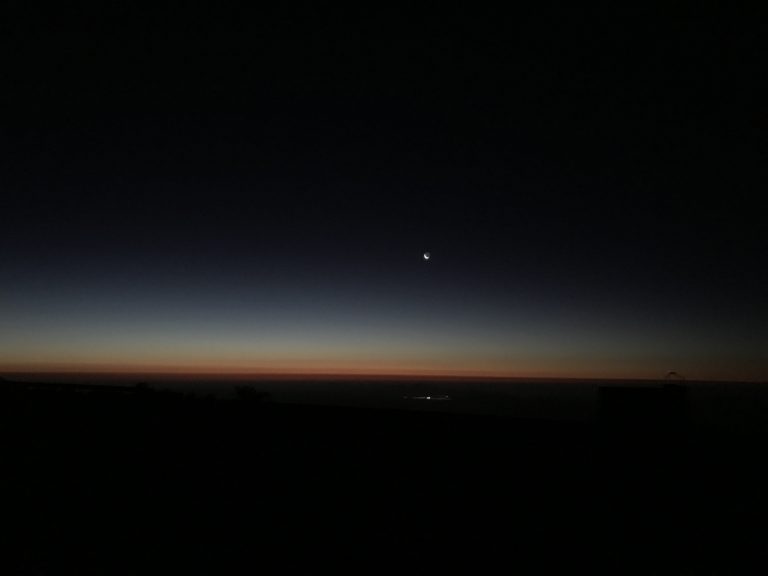
An observing night begins. The final goodbye to a sunset, and a hello to a lovely crescent moon and clear, beautiful skies. It’s easy to remember our passion for our research and our love for space on nights like these.
Deborah Gulledge, undergraduate at Austin Peay State University
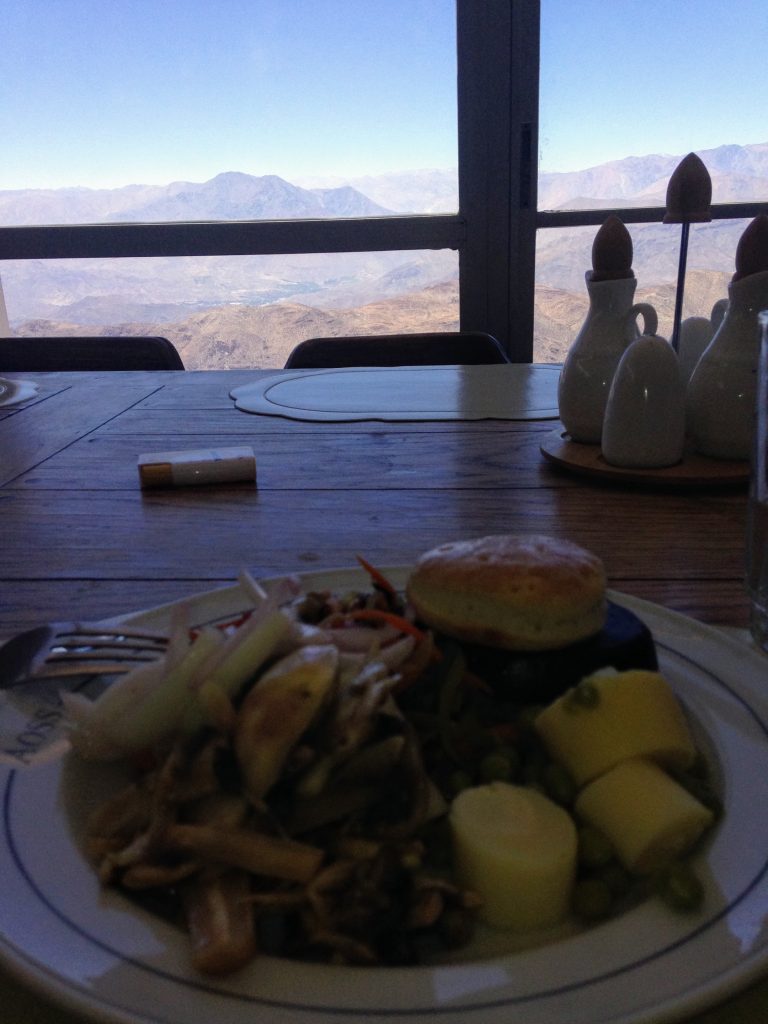
One of the greatest moments at mountain-top is having lunch with a great view and some company.
Ricardo Ogando, staff scientist at Observatorio Nacional
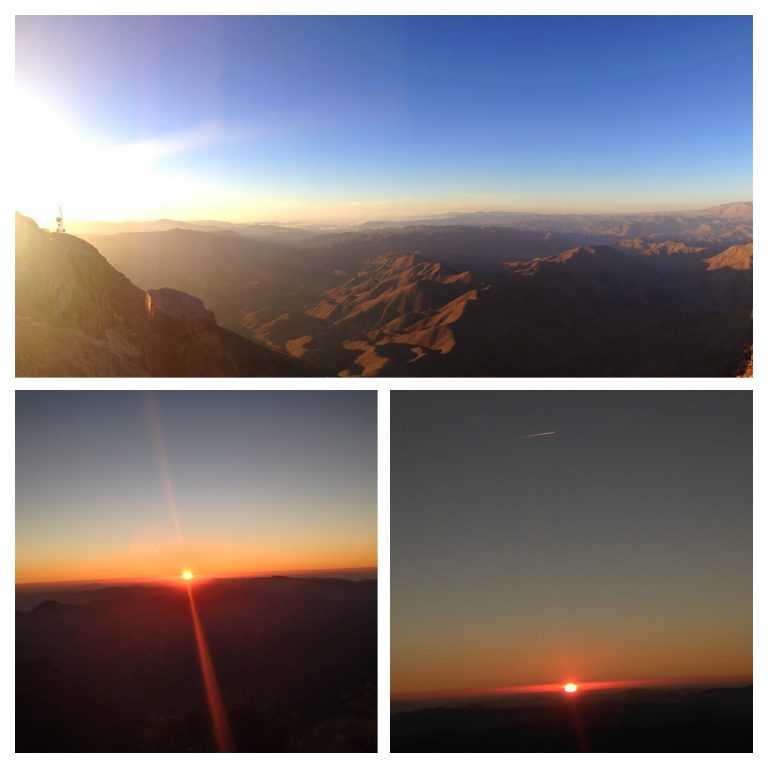
Observing for DES means going to the top of the mountain everyday, hoping to see a green flash during sunset.
Ricardo Ogando, staff scientist at Observatorio Naciona
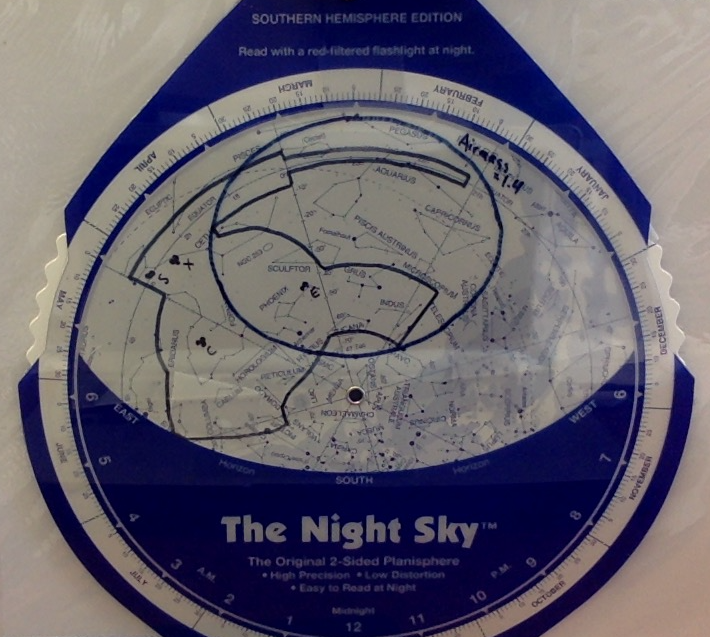
I remember one night making this star chart. Drawn on in black marker is the DES survey footprint!
Alex Drlica-Wagner, Postdoc at Fermi National Accelerator Laboratory
Dear DES –
As you have heard a number of times already, tonight is the last night of six years of DES data collection at CTIO, which gives me an opportunity to acknowledge the contributions of the many people involved with daily operations, and to thank them for their essential contributions to DES. The effort has required a huge team of talented and dedicated people, and DES has been fortunate to have them (you!) on board.
In the past six years, we have covered the wide-field footprint 10 times in 5 filters, with many additional exposures in the time-domain survey. We have observed on about 758 distinct nights, staffed by about 300 of you as volunteer observers. This activity has been supported by CTIO’s mountain-top professional staff: the Telops Team, the Computer Support Team, and the Engineering and Technical Staff Team. The excellent record of DECam and telescope up-time is clear testimony of the high level of support we have received fro CTIO. The cooperative work with NOAO and CTIO over the years has been a truly great experience. We are a leading example of what can be achieved scientifically with international cooperation.
A factor in NOAO’s decision to grant all of that telescope time to DES was the belief that our survey would benefit the whole astronomical community. That must certainly be true, even before we produce DR2, the final public data release. Besides the data, another legacy of DES is of course the camera itself. As a facility instrument for the community, DECam will continue as a premier optical survey instrument in the southern hemisphere. Again, numerous people were involved with building (and maintaining) the camera who deserve our thanks, and again it was a remarkable international undertaking, led by Fermilab and including several DES member institutions.
On a daily basis a dedicated staff at NCSA has been processing the exposures coming in from the mountaintop. Meanwhile the Science Release group, the Calibrations group, and others have been creating the data products needed for cosmology. These various operational parts are augmented with scientific input from many. The survey strategy and survey operations teams centered at Fermilab have provided essential coordination. There are so many parts to DES operations that I am sure I have missed several: apologies for that! The funding agencies and the individual institutions have been incredibly supportive throughout and of course deserve our thanks as well.
This morning I received this:
“Congratulations of the DES Council of Directors to the entire Dark Energy Collaboration and to everyone who has supported it, world-wide, on the completion of the observation phase. May you have similar success in the analysis of all of this great data!”
Indeed, after tonight, we need to concentrate on the analysis to get to the science, but that will be another story. In conclusion, my sincere thanks to all for the hard work you have invested to get DES to this point.
Best,
Rich
We’ve now come to the end of the #DESendofnights posts, and on behalf of the DES outreach team I’d like to thank you all for the interest you’ve shown in the best memories of our observers. Today is a big day for DES, and whilst we’re all very sad that there won’t be anymore observing runs, we are also excited by the challenge of analysing the huge amount of data that we’ve gathered over the last 6 years. This is not the last you’ll see of us, so keep an eye on this page to keep up to date with the fantastic cosmological results we’ll be publishing over the next few years! #GoodnightDES
DES EPO Team
